#especially in the Brooklyn sequence
Explore tagged Tumblr posts
Text
🚨 SPOILER ALERT
Is Bucky still a congressman? Sebastian Stan breaks down the Winter Soldier's return in Thunderbolts*
"Ultimately he realizes, 'No, I am who I am, and I do things how I do them, and I should just do that,'" Stan tells EW.
By Sydney Bucksbaum
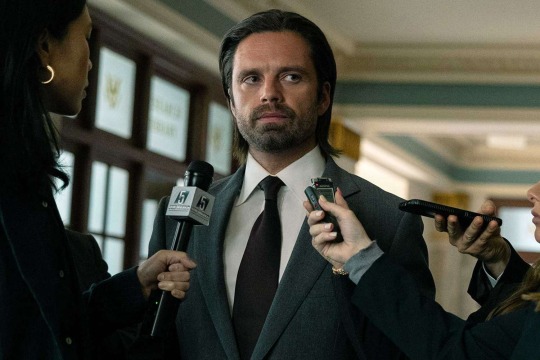
This article contains spoilers about Thunderbolts*.
The biggest shock in Captain America: Brave New World had nothing to do with Harrison Ford turning into a Red Hulk or Sam Wilson (Anthony Mackie) somehow surviving their fight despite not having any super soldier serum running through his veins. Nope, it was actually Sebastian Stan's quick, bizarre cameo revealing that Bucky Barnes... was running for Congress.
Yes, the mass-murdering, former Hydra operative was on the campaign trail, running for a seat in the House of Representatives. Why not! And as we learn at the beginning of Thunderbolts*, despite his decades of killing as the Winter Soldier, Bucky wins the race and becomes Brooklyn's congressman. Weirder things have happened in politics, but still...
However, as Valentina Allegra de Fontaine (Julia Louis-Dreyfus) snidely points out later in the movie, Bucky only lasts half a term before donning his black leather jacket, hopping on a motorcycle, and letting his Winter Soldier freak flag fly again. And with Val publicly declaring that he, along with the rest of the Thunderbolts team, is now the New Avengers, is Buckty's political career officially over?

Since it's not clear onscreen, Entertainment Weekly went straight to Stan to find out. "Yeah, it's almost like crossing it out, right?" the actor tells EW. "He's still been trying to find his way of how he can contribute in a way that he hasn't before. Ultimately, he realizes, 'No, I am who I am, and I do things how I do them, and I should just do that.'"
Stan laughs before adding, "But there's a lot of strange congressmen these days anyway, so..." As he trails off, his costar Wyatt Russell points out that Bucky wouldn't have to give up his congressional seat "technically, theoretically," to act as the Winter Soldier.
"The only issue I had was, 'Well, why is he growing out his hair if he's going to be a congressman?!'" Stan adds. "But I still wanted to grow it out, so I was like, 'I don't care.'"
Thunderbolts* director Jake Schreier agrees with Stan's answer about Bucky's political future being dead on arrival. "I think that's pretty well done," the filmmaker tells EW. "I think he's found a new place that makes much more sense for him."
When Stan learned that Bucky was running for Congress in his brief Captain America: Brave New World appearance, he remembers feeling "curiosity and apprehension" about that shocking new direction for his character.
"But I think it is funny," he adds. "I think it was an interesting turn that I didn't see [coming], and I think probably a lot of people wouldn't have seen."
Getting back on Bucky's motorcycle in one of Thunderbolts* best action scenes felt more natural, especially since it mirrored his MCU debut in Captain America: The Winter Soldier 11 years ago. "It was interesting because, after the TV show Falcon and the Winter Soldier, I think we got him further along in a good head space where I feel he is now just finally realizing how to incorporate some of those Winter Soldier characteristics and get a handle on them," Stan says. "And so it was fun bringing back some of those moments with the new Bucky that we've established and to find the humor and the cool, dangerous factor as well. That was nice."
The director confirms that the motorcycle sequence was an intentional callback to Bucky's original entrance.

"Having Sebastian actually out there on that bike and doing this stuff and no green screen to it, just felt really special," Schreier says. "Bucky is just such a legend within the world, and then obviously within the world of people who care about these movies. The trick is for someone who's on their ninth film, how do you do something new, because he has been through those therapy sessions in Falcon and Winter Soldier. He is not in the same place that the rest of them are in."
Schreier loved showing Bucky struggle with his new, "frustrating" political career, because it clearly wasn't an "honest" path for him, only for him to reappear "in a more healed version" of who he'd been before as the Winter Soldier. "Back on that motorcycle doing Bucky things," he adds, "but with a new group of people that, even if it's the least expected thing, might be the best fit for him because what he's gone through, they're going through now, and he has something to offer them in that regard.
Let's hope Sam can appreciate that and stop fighting Bucky over the group's New Avengers team name.
Thunderbolts* is now playing in theaters.
#Sebastian Stan#Entertainment Weekly#Thunderbolts*#Jake Schreier#Bucky Barnes#Winter Soldier#Thunderbolts#MCU#mrs-stans#StansClan#SStan#SebStan#sebastianstansource#sebastian stan source#sebastiansource#sebastianstannews#sebastianstanedit#sebstanedit#sebastianstan
103 notes
·
View notes
Text

RASPBERRY TARTS - p.m.
☾⋆⁺₊✧ part of my Marvel soulmate series, found here. .𖥔 ݁ ˖ pietro maximoff x fem!reader .𖥔 ݁ ˖ warnings: action sequence, mention of parental death, and small depictions of violence. .𖥔 ݁ ˖ 5.1k words. .𖥔 ݁ ˖ all you wanted was to run your shop, never did you expect to have your soulmate sprint into your life so chaotically.

The earliest memories you had were of your grandparents explaining soulmates. The exact cause was entirely unknown, but when a person was born they had the name of the person who shared their soul printed somewhere on their body. However, there seemed to be a split in the population; some people had the marks and others did not.
You happened to fall into the percentage of people who possessed a soulmark.
As a child, unable to understand much, you were excited at the prospect. However, as you grew and your grandparents revealed the truth of what happened to your parents, the idea of possessing a soulmate became bitter.
Soulmates were not guaranteed love, or even friendship with their partners. Sometimes it ended in a happy ending, other times it did not. Your parents had been the latter. Soulmates, yes, but it did not work out in the end. It was hard coming to terms with their ugly divorce, even more so the plane accident that left you an orphan and under the care of your grandparents.
Since then, the small words on your forearm seemed to glare at you. It was written in what you later learned was Sokovian.
Pietro Maximoff.
The name echoed in your head daily.
It all came crashing down shortly after the Ultron incident in Sokovia. You had been in a cafe in New York, scouting out places with your friend to start a cafe, when the news was captivated by the rising city. Then, months later, the Avengers revealed two new members that were caught on camera saving the citizens with them. Pietro and Wanda Maximoff.
You nearly had a heart attack that day and your friend, Evette, spent the rest of the day consoling you. She knew the name of your soulmate and had understood your rocky history with the concept.
Now, four years later, you and Evette had established a cafe in Brooklyn and have since moved on. Every day, you could absorb yourself into freshly made bread and other goodies and not have to worry about the very real fact that your soulmate was a superhero and living in the city. Under no circumstances did you want to meet him. If it ended so horribly for your parents, surely the same fate would befall you?
Especially if your soulmate was a high-profile person and the Avengers were not short on enemies.
You were in the front of the bakery during a lull in customers while Evette was in the back prepping some ingredients. Things were calm for once, which made you relieved to get past the morning buzz of customers. Your hand held a cloth as you wiped down one of the counters. The bell of the door rang out as a new customer came in.
You looked up to see a man who looked to be somewhere in his 40s. He had short, spiked dark hair and wore sunglasses. He was decently tall, fit as well, and walked with confidence. There was something there that was familiar, but you could not entirely pin it. He gave you a small smile as he came up to the counter.
“Welcome, how may I help you today?” You put the cloth down and wiped your hands on your apron nervously.
“I’ll have a medium black coffee with an apple fritter, please.” The man replied. You nodded while ringing his order up. While you were busy, he leaned against the counter.
“I’ve heard good things about this place, but never had the time to come by.” He spoke.
“Work keeps you busy?” You asked as you grabbed a to-go cup.
“You could say that,” He answered before taking note of your name on your name tag, “Don’t really come across that name often.”
You shrug at his words, “I always thought it was common.” You poured the hot coffee into his cup and put the lid on before grabbing a small paper bag and tongs to grab a fresh apple fritter from the display case. You packed it up and placed it next to the coffee on the counter.
“Well, it's nice regardless. I’m Clint. Good to meet you.” Clint gave you a friendly nod before turning to walk out of the door.
“You too.” You responded. Just as he was going to leave, the TV broadcasted a recent bank heist that was thwarted by some Avengers. Video playback showed a quick ray of silver shooting back and forth before it stopped, revealing Pietro, while the reporter spoke over the footage and recapped the events from just a few minutes ago.
You sucked in a breath. Pietro was undeniably an attractive man, which only made the situation worse. A superhero and hot? There was no way you could match that. Insecurity clawed at your heart for a moment.
“Pretty incredible guy, right?” Clint casually asked. You turned to him, only to see him already facing you with a look of curiosity on his face. There was something in his look, patience, waiting for which you did not understand.
Immediately you looked down at the counter, fiddling with a cloth while red coats your face, “I guess. I don’t really pay attention to that stuff.”
You cringed afterwards. Don’t pay attention to ‘that stuff?’ How ridiculous could you sound?
It was mainly the truth. You did not know the Avengers that well. It was never a priority for you. When the news of Pietro and his sister joining the team hit the media, you made sure to distance yourself as much as possible.
“Don’t blame you. That stuff is dangerous. Have a good day.”
The man left quickly, leaving you alone in the bakery. Again, that feeling of familiarity crept over you as you watched him through the front glass. You almost thought long on it, but a bell at the door and a new customer coming in caught your attention. A smile made its way on your face as you prepared to continue your day.

The ache in your feet was already prominent and it was not even midday yet. The morning rush had been especially chaotic with some convention being hosted down the street. Evette was working overtime in the kitchen and you had zipped back and forth behind the counter filling orders and trying to keep a smile.
When the crowd had dissipated, you slouched against the counter and stared at the floor with your eyes closed. It was a last-ditch effort to summon up some kind of will to continue working. A ding indicated a new customer. You immediately shot up and alert to greet them, only to relax and smile gently at who walked in.
Clint had become a regular, coming in every day for the last two weeks. He was always calm and good at conversation while being incredibly witty. There was something fatherly about the way he interacted with people. It was something you sorely missed and lacked in your life.
“You look dead.” Clint joked.
Your hand rubbed one of your shoulders to try and relieve the tension, “I feel dead.”
“Bad morning?” He asked while he looked at the pastries. One thing you knew about him was his insatiable attraction to baked goods. You were sure if the world came to an end, he would still run to the nearest bakery for a sweet treat.
“Busy. That convention down the street has a lot of hungry people.” You sighed as you adjusted some of the coffee brewing items behind the counter.
“You know, for someone who interacts with people as part of their job, you don’t seem to like them very much,” Clint spoke.
“Trust me,” Evette spoke as she exited the back with a tray full of fresh pastries to load the display case, “I’ve told her how ridiculous it is.”
You shrugged, “Big crowds aren’t my thing.” You were never a fan of crowded spaces; people shoulder to shoulder and speaking in shouts to one another. It was uncomfortable and only made you feel drained.
“Well, what about galas?” Clint slyly asked. Evette stopped loading the pastries into the glass and looked at him.
“What do you mean?” Evette asked.
“There’s this gala tonight and I got the room on my invite for two more. Does that sound good?” Clint asked as he eyed the raspberry tarts.
“Oh, uh-” You exchanged a look with Evette, prepared to turn him down before your friend interrupted.
“We’re both in.” Evette smiled at you. You gave her an intense look of disapproval. She had been trying to make you get out there and meet more people lately, but you had put up a good fight so far. Clearly, you were outmatched.
“Awesome. Here’s my number,” Clint slid a piece of paper across the counter, “Also, just my regular order, but I’ll take two of those raspberry tarts.”

Clint sighed with frustration as he sat on a high chair in the Avenger’s tower. His cup of black coffee, which was almost completely drunk, had gone cold. He had arrived to utter chaos in the living quarters. Pietro was running around, making markings on the ground as he jittered from place to place. Wanda sat next to Clint, happily eating one of the raspberry tarts as she watched her brother freak out.
“I do not see what all the fuss is about,” Wanda spoke as she took a sip from a glass of water. Despite it being four years since they joined the Avengers, their Sokovian accents were still as thick as the day they met the dysfunctional – but somehow semi-functioning – family of superheroes. Pietro stopped zooming around and took the second tart. He bit down, humming at the nice taste, before opening his mouth.
“This is going too fast. He was supposed to ease her into it.” Pietro rocked on the balls of his feet. For the first time in his life, he was nervous. A feeling he was not familiar with, nor ever wanted to feel again.
“Too fast for you, speedy?” Clint exclaimed with disbelief, “Days ago you were whining that I was not making any tangible progress and now, when I finally manage to make it, I am suddenly in the wrong?”
“Not like this. The gala is in eight hours!” Pietro started pacing. There was so much he had to do. He planned on having a grand entrance; a classic sweep-one-off-their-feet moment. He dreamed of it since he was a kid, even when he was unable to read the name of his soulmate as he had yet to learn English. It felt like he was staring down the barrel of a gun with limited time to move.
“It was almost as if this was a horrible plan in the first place,” Wanda spoke. Clint nodded her way in agreeance with her words.
“Look, you had Tony track her down and then sent me to scout the place. Remind me again why you think this is necessary?” Clint took a sip of his coffee, grimacing slightly at the cool temperature but still liking the flavour. Pietro’s soulmate makes a damn good cup, he thought to himself.
“I can’t even leave the tower without being swamped by people because your stupid American media does not stop chasing me. I don’t want her to be overwhelmed or put in danger.” Pietro reasoned. For some reason, the American media has chosen Pietro to be a darling representative of the Avengers. Sure, he was a flirt, but it had been taken too far and became nauseating to go out.
Clint hummed, “Fair point, but did you ever think that having me essentially lie to her these last two weeks was a good way to start this whole thing off?”
“Exactly what I said,” Wanda muttered before taking a final swig of her water.
Pietro paused for a moment, raising his hands to his face and digging the heels of his palms into his shut eyes, “I did not think that part through.”
“Do you ever?” Wanda teased. He looked towards his sister in challenge, but she only responded with a sly grin. His stress was getting to him and he took another bite from the raspberry tart.
“Look, we have until tonight to plan it.” Clint got up from his chair and stretched his legs a bit, “Now, what did you originally have in mind?”

This was absolutely ridiculous. Evette insisted that the cafe be closed early to prepare for the gala. For hours, the two of you got ready. Thankfully, you had an appropriate dress in your closet left over from a wedding you went to a year ago. It was good enough for the gala, but not anything entirely special. Evette spent hours on your hair and makeup, as that was something she was particularly gifted in.
It was odd to feel as pretty as you did, but the moment you showed up at the gala over an hour ago, it fled quickly. All the people here were stunning. The reporters, politicians, workers, and everyone in between. It was a charity event and the grandeur of the building shocked you. It was modern, elegant, and easily a damn expensive event.
You and Evette had been on the guest list, welcomed in, handed champagne, and walked into the area. So far, the two of you have not found Clint. Admittedly, you were having a good time despite being slightly uncomfortable with the amount of people that were there. For the most part, you and Evette stuck to one another and only engaged in a few conversations with people.
The two of you stood off to the side, engaged in a small conversation and sipping on champagne; both of you had lost track of the amount of glasses that had been consumed thus far. Both of you were looking out these large floor-to-ceiling glass windows that spanned the height of two storeys. The bright sparkling windows from the skyscrapers appeared to light up the dark sky.
“Having a good time?” The familiar voice of Clint came from behind you two. You turned to see him walking up. This area was more secluded, away from the dazzling crowd. He wore a crisp suit with no tie and the first button undone. Casual, but still fancy.
“It’s been alright.”
“This place is amazing.” Both of your voices chimed off at the same time. Clint laughed gently and stood up by you two. You felt an odd tingling feeling on your wrist where your soulmark was. It was covered by a thick bracelet and your fingers were unable to dig under and calm the itch.
“There is uh, actually a reason why you’re here,” Clint began. You turned to find him already looking at you. An unsettling feeling crept up your spine.
“Uh, guys?” Evette spoke, but it was whispered and unintelligible. She was looking out the window with an uncertain look painted across her face.
“What is it?” You questioned Clint. His hands folded in his pockets and he looked around the room as if searching for something.
“Well-”
“Guys!” Evette caught your attention and pointed down to the street to a pack of suspicious vehicles, “What’s that?”
You looked down the street to find vehicles moving at top speed, hurdling across the cement roadway. The two cars were large, armoured, and not stopping. For a moment, you froze while the worst thoughts flooded your mind. They wouldn’t, would they?
“Shit,” Clint said before grabbing you and Evette’s forearms and dragging you out of the way. In a clash of loud noise and shattering glass, the two vehicles rammed into the windows and pushed into the building. The shards dispersed all over the place, hitting your bare forearms and causing a bunch of cuts to open up. You gritted your teeth at the stinging sensation.
Everything was chaos. From your position on the floor, you could see people running all over the place while men in black clothes and balaclavas exited the cars with heavy weaponry. One of the men ran in your direction but stopped and fell to the ground instantly. You gaped in wonder when you noticed an arrow sticking out of his chest.
Evette’s familiar grip on your arms brought you out of your daze. Your head had taken a harder hit than hers and a pounding behind your eyes started to appear. Beside Evette, standing tall, was Clint with a bow.
Where the fuck did he get a bow from?
You watched as he shot another one of the invading men. It was then that you looked at him, really looked at him. Despite the chaos around you, your brain was finally thinking clearly.
Had you really been this stupid? For someone who wanted to avoid the Avengers, you were damn talented at letting one become a regular at your shop and friend. Shame and guilt filled you. You were not dumb, he knew who you were, he must have. Coincidences like this were unlikely.
Was this whole thing a setup of sorts? Did he actually stumble across your shop or was this planned? Before you could question anything further, you were brought back into the moment.
“Down that hall!” Clint pointed to a door off to the side, “Go to the end and take a right, get out of here!” He pulled an arrow out of a quiver on his back, nocked it, and fired with speed and efficiency that would have amazed you if it were not for how dangerous the situation was.
You and Evette wasted no time in heading towards the door with Clint following. He backed up with you two, focusing on shooting the men who scrambled across the floor of the grand hall. Evette opened the door to expose a long hallway, only to see that there were similarly dressed men there too.
One of the men lifted his hand that held a glock. Clint, being closer to Evette, had a faster reaction time and managed to pull her out of the way. However, it left you vulnerable to the men in front of you. Before you could even think, a flash of colour blurred in front of you. Within a second of time, the two men lay on the ground incapacitated.
Standing before you, was the person you did not ever plan on meeting.
He was slightly taller than you expected, but just as rugged as the videos he appeared in. Pietro wore a white button-up with a loose tie around his neck. His clothing was dishevelled, indicating he had been fighting the invading men well before showing up to play rescue. Your heart felt like it lodged up into your throat.
Pietro was better looking in person – if that was even possible. His silver locks with dark roots suited him, coupled with a strong nose and sharp jaw that was covered in stubble. He was obviously fit by the state of his muscles, especially the strain of his biceps against the white fabric of his shirt which had the sleeves rolled up just below his elbows.
His eyes were the most striking part of his appearance. Vibrant and alert given the situation, but still somehow soft. There was a reflection of familiarity in his pupils, and you immediately understood that he may already know about you. It only added to the evidence you had that Clint’s appearance in your shop may not have been a coincidence.
Pietro opened his mouth like he wanted to say something, his gaze never wavering from you, but the sound of a high-pitched scream back in the main room had his eyes snap to behind you.
It was interesting to watch the silent conversation he had with Clint in those few seconds. Clint gave him a curt nod, almost as if giving reassurance, before you blinked and Pietro was gone; likely off to continue fighting. This dull ache settled in your chest at his disappearance and the itching feeling on your soulmark faded the further he left.
Clint wasted no time in grabbing you and Evette and marching down the hall towards the exit door. He moved with speed, mainly so he could return to the fight. When he opened the door, a sleek back car was waiting in the alleyway. You had no idea how it got there or what it was originally for, but you did not have time to question it. Clint opened the back door and gestured for you and Evette to go in.
“The car will take you home. It will drive to shake off any potential followers. Once home, lock your windows and doors and cover them if you must.” Clint spoke.
Evette looked like she wanted to speak, but was stunned into silence and gratefully nodded before getting in. As you moved to follow her, Clint grabbed your wrist gently. You looked back at him with confusion.
“It was not supposed to happen like this. I hope you know that.” With those words, you finally understood that this was, in fact, planned. The break-in by those guys was not, but your invitation from him was very much intended. Pietro’s attendance at this event was intentional.
It almost hurt to think that Clint’s intentions were not casual. He had walked into your store, knowing damn well who you were – or at least who you were to Pietro – and acted accordingly.
All you could do was nod before joining Evette in the car. Clint closed the door and it automatically locked. He quickly went back inside and the car took off down the alleyway and to the street. You looked forward and saw that there was no driver present.
It was only until you had reached down the block that the adrenaline wore off and you could feel the pain of the cuts on your arm. Even worse, the dull ache in your heart.

The rattling buzz of your phone broke you out of your monotonous clean of one of the tables. You stopped your clean-up work and pulled it from the back pocket of your jeans. Clint’s name flashed across the screen and, like the many other times he has tried to call, you denied it.
It had been almost a week since the incident at the gala. According to the news, the infiltrators were there because the organizer owed the mob. They were stopped, of course, mainly by Clint and Pietro – which the news kept playing footage that bystanders caught during the altercation. Thankfully, you had not been in any of them and you took that as a positive sign.
Since then, Clint has tried to contact you. Truthfully, you were reluctant. The incident only proved one of your underlying fears; how unsafe you would be as a soulmate to an Avenger. The answer was lacklustre, though Evette had been trying to convince you otherwise. She wanted you to reach out and talk to Pietro at the very least. What bothered you the most was that she was right.
Over these few days, you had thought about it. It was not fair for you to isolate yourself from your soulmate. He did not deserve that. This was not a one-way bond, but a shared commonality. A shared soul. You did not want to be cruel to the person that was fated to you.
Admittedly, you were also scared. A soul bond did not necessarily mean a perfect connection. Would you even be good enough for a literal hero? You co-owned a cafe with your friend and played video games with her on the weekends. It was not exactly an exhilarating life. Would he even want an exhilarating life? Would you be boring?
You shoved your phone back into your pocket and took a centrepiece from the table to move behind the counter. As you were crouched down and organizing, the ring of the bell caught your attention.
“Oh, sorry but we are clo-” Your words faded away as you stood up to see Clint there. He was standing casually by the door. You soulmark began to itch you you clocked the situation immediately.
“He’s outside, isn’t he?” You asked. Your hands tapped the counter awkwardly as you tried not to sway on your feet.
“Yes,” Clint nodded, “He’ll come in if you want him to.”
“So, you’re still working as his little spy?” The comment felt harsh as it fell from your lips and you cringed slightly.
Clint sighed, “Look, if you could let him explain.”
You almost wanted to laugh, “How he sent someone to essentially spy on me? Tell me, what did you learn in your reconnaissance?” It felt odd, having been treated like a mission. You were made a target of which they needed to gather intel on. Not a person, not even his soulmate; a mission. Would that be your life with Pietro?
Clint only leaned against a table, “You know he almost died in Sokovia.” It was not a question, but a bold statement that almost knocked you from your feet. That you did not know and the thought of it…
“There was this kid I was trying to get out of there and, uh,” For the first time since meeting him, Clint got visibly uncomfortable and one of his hands lifted up to scratch the back of his head, “Pietro ran and took the bullets for us. By all accounts, he should have died but… he wished for us to find you if he didn’t. To take care of you.”
His words felt like a direct punch to your face. You had been so selfish, so terribly selfish because of your fear that you never thought about him. His life of danger, of possibly never meeting you.
“That kid is alive because of him. My kids still have their father because of him. All I’m asking is to give him a chance.” Clint finished his speech and waited for a response. You could not look at him, unable to reckon with it all.
As if on instinct, you quickly went to brewing coffee as you silently contemplated his words. While it brewed – and you were sure to regret it later as it had already been cleaned for the day – you grabbed tongs and picked out and bagged the last apple fritter; Clint’s favourite.
You placed it on the counter, along with the coffee you poured, and pushed it towards him. Clint made a move to reach into his pocket for his wallet, but you held out your hand.
“Dont. Just take it and,” You paused to breathe out, “You can send him in.”
Clint grabbed the items with a small smile on his face and gave you a nod. He made his way outside your shop and turned down the street and out of sight. You looked down at your hands as they shook with nerves. One of your hands fiddled with a ring on your other, turning it around and around as you waited with bated breath.
The familiar ding of the bell above the door caught your attention. Looking up, you spotted Pietro standing in your shop. He wore casual clothing this time, dark blue jeans with a gray hoodie. His hands were in his pockets and you could tell he was nervous too. Again, you found yourself paralyzed by his eyes.
“I feel I have to explain myself,” Pietro spoke. You crossed your arms and nodded, unable to speak.
“Clint was only doing me a favour. I was worried how you would feel about, well, me and my life, the Avengers…” He trailed off for a moment and took a few steps closer, “It can be overwhelming and dangerous at times, as I am now sure you know. Are you okay?”
“Only a few cuts. Nothing horrible. You?” You had managed to walk out from behind the counter, but for some reason found yourself unable to get closer.
“I’m fine. It was not supposed to be this way, I had planned on having some grand entrance. Sweep you off your feet. Not see you get hurt.” Pietro closed the distance. You noticed immediately how much taller he was. By now, the itch in your wrist has become intense.
Pietro slowly reached out and used his hands to grab your wrist. He carefully pulled up your sleeve and exposed the soulmark on your wrist. His name, in bold black elegant letters, was sprawled on your skin.
The moment his calloused fingers touched your skin, the itching ceased. Warmth pooled from the area and moved throughout our body. With your one free arm, you pulled up the sleeve of the hand that brushed over your mark and saw undeniable proof of your connection. Your name, sprawled in the same writing, was printed on his wrist. You touched it and you could feel him shudder under the sensation.
“I, uh, still can be. Be swept off my feet, I mean. If you want.” You could not help but stutter. His close proximity, the smell of fresh mint and lavender, overwhelmed you. It did not help that the two of you seemed unable to let one another go.
“That I can do.” Pietro smiled and turned over your hand, lifted it up, and brushed his lips across your knuckles without ever breaking eye contact. You could feel heat sweep across your face, which was no doubt red.
“Smooth. Should that make me worried?” You asked.
“Did you not say you wished to be swept off your feet?” Pietro answered. “Though I hate to ruin the immersion, I can’t help but ask, even if you are closed, if you happen to have any more of those raspberry tarts. Clint brought some this morning and, I have to say, you are good.”
You could not help but be reminded of words your grandmother always repeated; the quickest way to a man’s heart is through his stomach. If it were not for such a tender situation, you would have laughed.
You smiled at him, watching as he grinned back, “Well most of the food is made by my friend, but the tart is one of my recipes. We’re out but uh, we can make more right now if you want.” You were surprised by your own boldness. The experience you had with men was lacking, so your nerves on navigating uncharted waters ran high.
“That sounds good,” Pietro answered. He gently pulled on your arm, bringing you somehow closer. His hand left yours to tuck some hair behind your ear, “Would it be alright to kiss you?”
“Normally, yes, but I can let it slide.” You answered.
Pietro took your invitation as a go and leaned in. You closed your eyes and lost yourself in the feeling of his lips brushing against yours. His stubble ticked just lightly, but it felt comforting. The warmth from his body ran higher than normal and you suspected it was due to his abilities. Your hands moved to his chest as you gripped the fabric there.
Your heart was alight, buzzing with excitement as his lips moved against against yours. For the first time in your life, a thought burrowed itself into your mind.
Maybe soulmates aren’t so bad.

.𖥔 ݁ ˖ It was so hard not to turn this into a 15-20k word long fic. istg it’s like fighting demons.
.𖥔 ݁ ˖ Click here to be added to the taglist or comment below.
.𖥔 ݁ ˖ Taglist:
@kitwithnokat @theamazingtrinitysky @kay18115 @raikan624 @pigeonmama
#pietro maximoff#pietro maximoff fanfiction#pietro maximoff imagine#pietro maximoff x you#pietro maximoff x reader#quicksilver#aaron taylor johnson#pietro maximoff one shot#pietro maximoff fic#marvel#mcu#avengers#x reader#fanfiction#fanfic#imagine#atj#atj fic#soulmates#soulmate au
101 notes
·
View notes
Note
What didn’t you like about The Super Mario Bros Movie?🤔
I feel like I'm just gonna repeat what has already been said a hundred times over, but... Number 1 is the pacing. This movie could've benefitted so much from just an extra fifteen minutes tacked on. The experience of watching the film for the first time is comparable to going on a guided tour in a beautiful location with a super impatient tour guide who is eager to clock out. You want to take in the scene and enjoy the moment, but next thing you know you're being aggressively shoved to the next scene without a second to breathe.
Number 2 is the jukebox songs. "No Sleep 'Til Brooklyn" was fine. "Thunderstruck" was annoying. "Take On Me" was inexcusable when you listen to the song that was supposed to be playing during that sequence!
youtube
And look, I can sorta get what they were going for if they were trying to reference the pop songs that played during The Super Mario Bros Super Show, but the amount of people nostalgically connected to The Super Show is easily dwarfed by the amount people nostalgically connected to the OG music of Nintendo (no hate on Super Show enjoyers of course, just stating the facts.) You've got an incredible catalogue of music at your fingertips and a talented composer! Take advantage! Please!
Number 3 is (some of) the casting
Jack Black, Charlie Day, and Keegan-Michael Key were fantastic (Keegan-Michael Key in particular I feel doesn't get nearly enough credit for balancing sounding like Toad of all characters while not being grating to listen to, and actually putting in a darned good performance.) Chris Pratt was okay. His voice was surprisingly fitting for Mario once I saw it? It's very everyman while being a little naturally high pitched. The one thing he lacked was the super high Mario-levels of energy. The yelling in particular needs work. Speaking of yelling... I know they kept the actors in separate recording booths for secrecy reasons or whatever, but I think Chris Pratt would greatly benefit from sharing a recording booth with Charlie Day. Especially if The Mario Bros. are going to be on screen together in future installments. DK, too, I feel was just okay. Not distracting, still pretty funny, but he didn't wow me.
Anya Taylor-Joy was, unfortunately, kind of disappointing. It feels like they just went with a "pretty lady actress with a lady voice" in the casting call. She doesn't really sound much like Peach, and her delivery falls a little flat at times. I prescribe... putting her in the recording booth with Jack Black.
As for Fred Armisen's Cranky Kong, I have to mute and put on subtitles when he's on screen. I give his performance a solid 2/10 because he is putting in energy, but the delivery is so off and the voice doesn't fit. It's actually really distracting.
32 notes
·
View notes
Text
Train in Vain: Chapter 1
Notes: Never done this before, I've only ever written academic essays for grad school etc. I got the idea for this story on the train the other day. Wanted to play around with Kid's characterization and his relationship with Kil. The amount of space Kid and Killer are occupying in my brain lately is unhealthy and I especially loved the HC I'd seen of them being in a punk band together. I'd originally thought of this as a one-shot, but I enjoyed writing it so much that I will keep going! My plan atm is to upload another chapter by next week. Please let me know what you think! Going to try to improve my dialogue and action sequences. The general idea is that it'll all happen over the course of one night, like an After Hours, or American Graffiti situation. TWs: Reader is a woman. Sexual harassment of reader. Brief mention of an imaginary sex scene. Light violence. Implied drinking and drugs. Implied familial pressure and sexism. Cursing. Minors dni.
On AO3 I gave it an M but it's a lighter M. Here's that link: https://archiveofourown.org/works/53565769
Summary:
You're headed out on a Saturday night when some cute punks help you out of a sticky situation. Next thing you know, you're tagging along to their concert. This isn't something you'd normally do, but they're nice to look at and you need a little more spontaneity in your life. Let's see where the night takes you.

The man was slumped against the faux wood-paneled wall of the train car. You only noticed him because of his massive, muscular frame. He was your age, late 20s, but he had a boyish charm about his face that made you grin. A mischievousness that was noticeable even with his eyes closed as he was currently. His hair stood up in a dark red shock like he'd stuck his finger in an electrical socket. He was pale and riddled with piercings, metal spikes jutting out from his nose and ears giving his angular face an even sharper appearance. He wore goggles loosely at the top of his forehead. A punk aesthetic that seemed simultaneously meticulous and nonchalant. You noticed his massive left arm was metallic from the elbow down. An equally large man sat beside him on the seat to his left. The man was blonde with long hair that layered itself in sharp locks down his shoulders. He had an old-school soul patch that softened his sharp jawline and drew attention to the blue paper mask he wore courteously over his mouth. He seemed tired in a way that betrayed his rough exterior. His traps were huge and strained against the collar of his worn blue t-shirt. Seeing their muscular physiques made you hold your breath albeit briefly as you boarded the train and quickly slid into a newly available seat.
It was mid-Saturday evening and you were making your way to a bar in south Brooklyn to meet up with a friend from college. She'd recently had a baby and her husband had been begging you to take her out. She was always so responsible; you'd historically been one of her very few bad influences and her husband loved you for it. Despite what she would say when pressed, she enjoyed the thrilling sense of ease you coaxed out of her typically rigid demeanor. Your relationship was easy. She didn't need to text or call you to make sure you still felt involved in her life. You could pick up right where you left off, be it months or years since you'd seen each other.
This was how you lived most of your life. Your family and upbringing were so exhausting that you felt an aversion to friction of any sort. That didn't mean you weren't responsible, of course you were. You always did what was expected of you or what you thought needed to be done. You were the oldest girl, rebelliousness was a luxury reserved for other people. Despite this, you carved out ways to satisfy your inner hellion as you could. Little rebellions that you could control but still scratched the itch you had to break everything down. You drank too much, but not enough to be a real issue. You smoked too much weed, only once it became legalized. You had a serious problem with authority figures or anyone for that matter who had the gall to tell you what to do. You would never cause an actual scene, but you'd fume for weeks after the encounter, thinking of clever ways to handle the situation in retrospect. You had a smart mouth, and while you rarely used it on high, your colorful vocabulary and quick temper had gotten you in serious trouble a couple of times before. You secretly loved using your words to cut someone down to their core, but only if they deserved it. When that side of you showed, the really mean one, no one could keep up with you. People would stare at you, eyes wide and mouth agape at your ability to so quickly discern what they truly hated about themselves and launch it back in their faces.
Aside from its ever-looming presence, this side of yourself was far away from you tonight. You were excited to see your friend, and shockingly the sun had been out today after nine days of straight rain. You had your AirPods in and were listening to one of your throwback playlists on Shuffle. The Clash rang in your ears, barraging your poor eardrums with excessive volume as the train hitched and swayed down the tunnel.
You let your gaze travel back up to the two large men at the other end of the train car. It struck you that it’d been a while since any man had touched you, let alone one as cute as the guys you were ogling shamelessly. You leered at the veiny forearms of the blonde, thickly folded into a taught cross over his chest. Your libido, ever your betrayer, flashed an imaginary scene in your mind’s eye. A vision of the man's vascular forearms tensed in a wrought-iron grip around the edge of a table in front of you, while he fucked you mercilessly from behind. You imagined what his strong body would feel like pressed against your back. A warmth bathed over your skin, your imagination tricking your synapses ever so gently. The warm sensation quickly shot upwards to your cheeks as you realized that the man was watching you stare at him. His expression wasn't judgemental or surprised, just thoughtful with the faintest hint of a smirk behind his mask. Your face flushed beet red and you quickly shook your head back and forth, attempting to convey to the man that you were not, in fact, ogling him but rather staring into the distance and were abruptly brought back to reality. This pathetic coverup attempt made you feel even more guilty since you knew your lustful gaze had been obvious. You averted your eyes down and to the right, tracing the lines made by an errant shoelace discarded on the floor.
The movement of the train broke you out of your shameful reverie. The driver pulled the break surprisingly hard into the next stop and your body lurched forward with the car. You steadied yourself on the wall to your left and watched as most of the people in your car streamed out of the train car doors. The older woman who had been sitting next to you disembarked and in her stead, a lanky brunette man with a buzzcut flopped down next to you dramatically. He gave you a shit-eating grin as your eyes met his and you quickly looked away.
You thought you felt a gaze from further down the train watching you closely but you didn't move or look up in an attempt to discourage your newly arrived neighbor from talking to you. This evasion failed miserably as he tapped you on your right thigh a little too high for your liking.
“Nice weather today, right?”
“Yep.” You said as you took out your right earbud.
“Where you headed?”
“To see a friend. What about you?” You mentally kicked yourself for engaging with him. Why were you so deferential?
“Me and my buddies are going out. Keeping the party going.” He nodded to a man to his right sitting across the aisle. His buddy was cute, like him, but something about him unsettled you. Something about both of them.
“Cool,” you said as you tried to put your earbud back in.
You noticed how empty the train car was. You and these two guys were the only ones on your end of the car. Why did this guy have to sit right next to you?
“What bar are you going to?” He asked quickly before you had the chance to put your earbud back in, so you stopped, holding it aloft.
“Baratie. It's nautical-themed.”
“Sounds cool. What's your friend's name?” He asked, staring you in the eye.
“Um, Amanda.” You said slowly.
“Hah. Good. I thought you were gonna say a guy's name.” He said and chuckled to himself.
“What?” You asked instinctively.
“I thought you were gonna say you had a date.” He explained. You were still confused.
“What do you mean?” You asked dumbly knowing full well his implication.
“I mean a pretty girl like you should come out with us tonight,” he said, his smile turning more nefarious by the second.
You'd never thought of yourself as pretty, and being called a girl made you feel infantile.
“Excuse me?” You asked not very aggressively
You knew that men generally found you attractive. You didn't know to what extent, but you knew on some level that you were cute. You never felt beautiful, that was a word reserved for tall, model-like women who were pretty in an ethereal sort of way. The women you found yourself watching in restaurants and clothing stores who made your heart skip a beat. They always seemed so effortless.
You were the opposite. You were small and round and angry and everything you did was full of effort. You weren't tiny but you were short. Despite your size, you always felt enormous and awkward. You were always moving out of people's way because you felt so brazenly wide. This feeling came from being muscular. You weren't ripped but you'd always played sports growing up and took every opportunity to carry things so that your mother didn't have to. You were a force of sheer mass and will. Femininity felt out of reach for someone who took up space.
Despite this, men found your willingness coupled with your small stature endearing. Your muscles and general meatiness meant that you had a curvy body which betrayed how seriously you took yourself. Your boobs were objectively huge which made you feel fat. Your large bust in tandem with your wide shoulders and back made you feel like you were going to hulk out of lithely cut women’s clothes. You didn't shop frequently, opting instead to wear t-shirts that swamped you in their width. You had a bit of a belly from your enjoyment of craft beer but generally, you were in good shape and attractive. You'd never admit this to anyone, but you saw the way people looked you up and down in bars.
Self-consciousness flooded your brain as you stared at the man sitting next to you. What did he mean?
“Oh, haha, no thanks.” You replied tentatively.
“Don't be shy,” he said, wrapping his long arm around your shoulders. You could smell minty alcohol radiating from the back of his throat.
“Haha. No, I'm good. Gotta meet my friend.” You said attempting to shrink from his grip.
His hand tightened and tensed on your left shoulder. He leaned his face into your right ear.
“Come on, don't be a bitch.” He cooed, his hot breath making you shiver in his arms.
All the color drained from your face and your heart sank. “Fuck,” you thought to yourself as your brain scrambled for ideas on how to escape.
His friend across the aisle laughed as he pulled you in closer to his body. He discreetly placed a soft kiss on the base of your neck.
“I know you want it.” He whispered. “My buddy and I will show you a good time.” You felt his fingers drift to your inner thigh as he squeezed lightly.
You froze from shock. Your brain descended into a panic as fear wracked your body. You couldn’t move.
Suddenly, the man next to you was yanked into the air and thrown to the floor of the train, his body making a loud thud as he skidded to a stop across the linoleum. The train bounced as your gaze trailed up the strong legs of the man now standing in front of you. It was the masked blonde man from your earlier fantasy. Your shocked expression caught his gaze. There was a silent rage behind his eyes. You didn't know how he crossed the train so quickly to launch your harasser out of his seat, especially in steel-toed boots, but you were grateful for it. The redheaded punk was still asleep, head resting on the wall.
The harasser’s friend, the man sitting across the aisle from you started to yell. He tried to get up in the face of the masked man but was violently shot backward with a swift roundhouse kick. The harasser got up off the floor while the masked man used his inertia to quickly pivot his feet and turn to face the incoming attack. He caught the harasser’s fist with his large left hand and parried with a swift punch straight to the guy’s jaw. You heard the crack of bone when his fist hit the man’s face. The harasser was once again, propelled to the ground, blood spraying from the side of his mouth. You gasped and covered your mouth with your hand in shock. You’d never seen a real fight before.
At that moment, the train car doors opened, and, seeing the chaotic scene, the people on the platform yelled in horror and diverted to other cars. You noticed the redheaded punk was now awake and smirking at his friend’s handiwork, his large arms crossed over his chest. The masked man paused, breathed out calmly, and turned to face you. You held your breath. His right fist was covered in blood, so after a thoughtful pause, he extended his left hand out towards you.
“You okay?” He asked. His voice was steady and reassuring, his large hand extended towards you, palm facing upwards.
“Um. Yes. I’m alright.” You stuttered, still in shock. You looked the man in the eye. The rage from earlier was gone and all that remained was tentative concern. He seemed worried that you would spook at any moment, like a wild rabbit caught against a fence.
Sensing no malice in his gaze, you gingerly placed your hand in his. It was calloused but warm and reassuring. He clasped your palm and helped you to your feet with surprising gentleness.
“Well I doubt we have much time after that performance” the redheaded punk spat from down the car, standing from his seat. His booming voice filled with deadpan amusement shocked you out of your daze. You looked around, people were whispering and looking at you through the train’s windows. You saw the station cop start to hustle down the platform towards your train car, “Hey! You three!” He yelled as he picked up his pace. “I've got an assault on a train down here” the cop barked into a walkie-talkie on his right shoulder.
The masked man put his hand on your right shoulder and looked at you, “Sorry, about this, but we gotta get moving.” In one swift motion, you were gracefully floated from the ground. The masked man draped your body over his left shoulder like it weighed nothing and held your legs snug to his chest. The redhead laughed raucously as they dashed out of the train car with you in tow. The masked man and the redhead ran side by side as they picked up speed, busting through the emergency exit door and darting up the station’s long walkway to the street. The yells of the station cop echoed into nothing as you emerged up, into the cold night air. The two men didn’t stop running until they reached an alley two blocks away. The masked man lowered you gently to your feet and they both hunched over to catch their breath.
“Kil, I’ve never seen you manhandle a chick like that” the redhead howled.
You tensed.
“Kid, you heard the cop, she was gonna get detained. I had to get her outta there.”
“How fucking gallant of you, asshole. What are we gonna do now? That wasn’t our stop.” The redheaded man finally caught his breath and stood up to his full height. He was huge, even taller than you’d originally thought. The masked man was broad and taller than you but the redhead had to be at least 6’5.
“Um excuse me. I’m here too.” You said looking from one to the other. On hearing this, they both turned and looked at you.
The redhead furrowed his brow at you, “Yeah, we know. You got us into this mess.”
Your jaw fell open. “How is this MY fault you’re the ones who basically kidnapped me!” You said incredulously.
“Yeah, if my buddy hadn’t saved your ass you’d be in a holding cell all night being questioned by Paul Blart.” The redhead shot back, his intense golden eyes boring into yours.
“Kid, knock it off. You know it’s not her fault.” The masked man waved dismissively at the redhead. “My name is Kil. Sorry for escalating things. Just thought you needed a hand.” The masked man reached his hand back out to you.
You took his hand and shook it lightly. “No, I appreciate it. Thank you.”
Kil shot a thumb at the redhead, “This ray of sunshine is Kid.”
Kid crossed his arms over his chest and averted his eyes from yours. “Pleasure.” He mumbled.
“He's not that bad when you get to know him,” Kil added. “We’re in a band and are meeting up with our mates for a show later.”
“Oh that’s cool,” you said, “what kind of band?”
“Punk, genius” Kid tsked and gestured towards his outfit with his metallic forearm.
“I didn’t ask you, ginger” you snapped back. Out of the corner of your eye, you thought you saw Kid’s lips shoot up into a reluctant smirk.
“Like Kid said, we’re a punk band. You’re welcome to come to the show if you’re interested, but I’m not exactly sure how we’re getting to the venue anymore.” Kil answered.
All of the commotion had made you completely forget about your own plans. “Shit!” You yelped and dug for your phone in your purse. The screen lit up and you find a text from your friend. “Hey I’m so so sorry but Lulu is coming down with something from daycare. I don’t think I’m gonna make it out tonight. Rain check?” You frowned at your phone. You’d wanted to see your friend tonight but hoped her daughter would feel better.
“So are you coming or what?”
You looked up. Kid was staring down at you, eyeing the message you’d pulled up on your phone. He had an expression in his piercing, golden eyes that you couldn’t read.
You paused to think. You didn’t know these guys, but despite their gruff exteriors, you felt decently comfortable with them.
Maybe it was because you’d already done your hair and makeup, maybe it was because you were still full of adrenaline, maybe it was because you thought of yourself as more rebellious than you actually were, or maybe it was because looking at either one of the men made your insides twist into knots, but for whatever reason you cracked a wry smile and replied,
“Yeah, let’s do this.”
#eustass kid#eustass kid x reader#killer one piece#massacre soldier killer#killer x reader#eustass kid x killer x reader#one piece x reader#one piece fanfic
18 notes
·
View notes
Text
Darkside Deliver at Sold-Out Brooklyn Steel
Darkside – Brooklyn Steel – March 22, 2025

As Darkside, Nicolás Jaar and Dave Harrington make challenging music, but not inaccessibly so. It has a haunting quality. It’s lush and weird and melodic, and spooked and a little shimmery, and eerie and groovy and sonically layered. It can get so ethereal as to be ambient. It can also get funky and dirty and full-dance-party-rage-y.
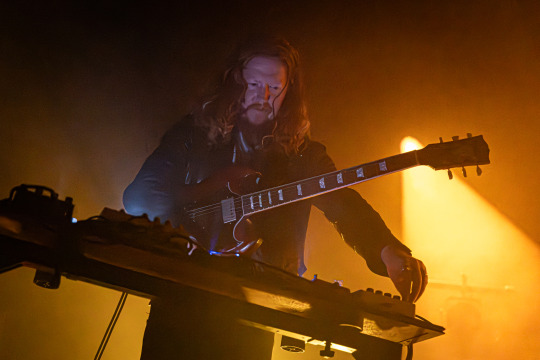
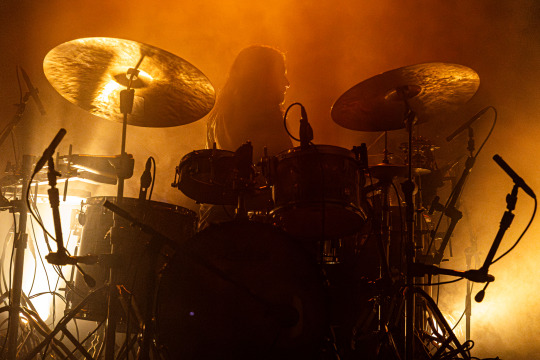


You could pick virtually any of the now-trio’s (we’ll get to that) tunes as a usefully representative sample of what they sound like now, but “S.N.C.,” which anchored a commanding spot late in their Saturday night set at Brooklyn Steel, had especially potent energy, so here goes: A moody, clopping rhythm that seems like it’s going to stay at a steady clip and then a lift into funkier, reverb-ier territory with clavinet and other keyboard effects as an angsty vocal surrounds the phrase “There’s nothing on my mind” before further opening into an elliptical, guitar-driven jam, trudging through that same funkier groove but somehow both murkier and more industrial-sounding.
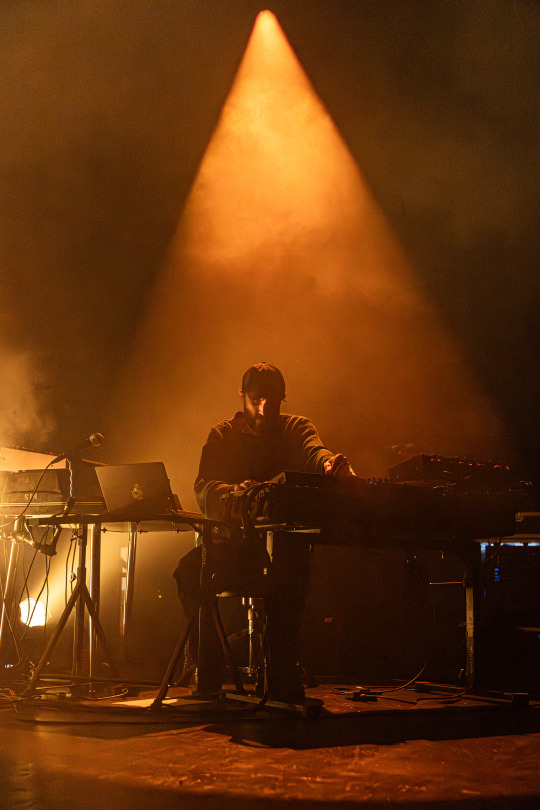

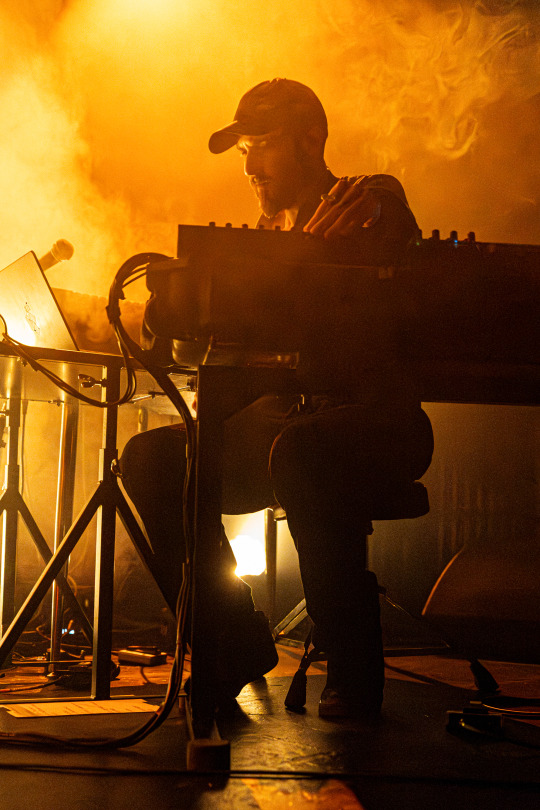
At first listen, it feels like three different ideas for tunes joined together, and then somehow, you’re in a weirdly satisfying vortex where all three of those modes have merged into one, playing off each one another, resolving back into the original clopping. Like many a Darkside sonic texture, the “S.N.C.” groove is (or at least feels) winked at during other tunes throughout Nothing, Darkside’s 2025 album, third overall, and the impetus for their first North American tour in more than a decade. A lot of their compositions are like that, and they hang together both thematically and sonorously despite being at times very different from one another.
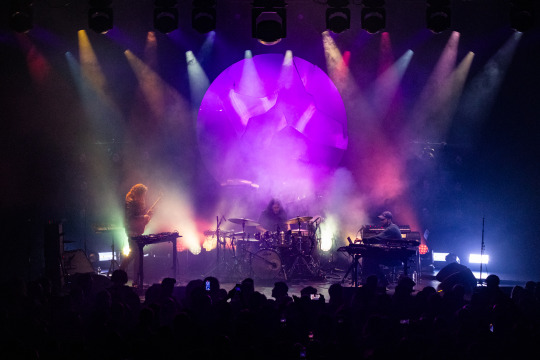
There is a new historic shift in the band: Jaar and Harrington added drummer-percussionist Tlacael Esparza as a full-time member — a seminal move for a project like this that relies so much on the trust and mind meld of its two cofounders to push at experimental limits without evaporating, sludging or otherwise losing its way. Esparza, on the record certainly but in the live setting especially, pays off the bet tenfold: Even Darkside’s most spectrally psychedelic and austere music gets a rhythm jolt that, throughout their two-hour set on Saturday, felt heavier and more prog-y than Darkside’s past — another thrilling ingredient that could-but-doesn’t spoil the broth.
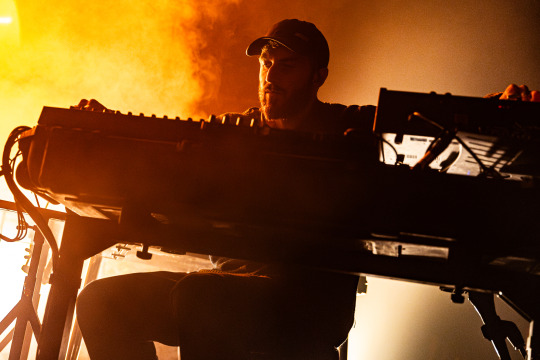
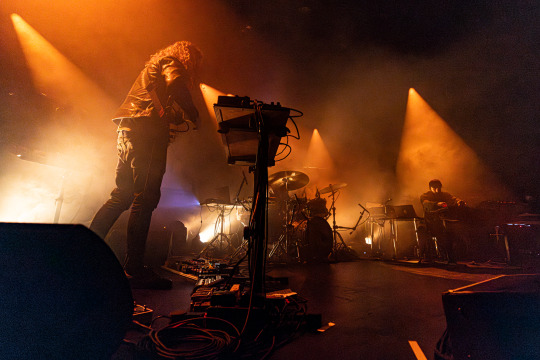
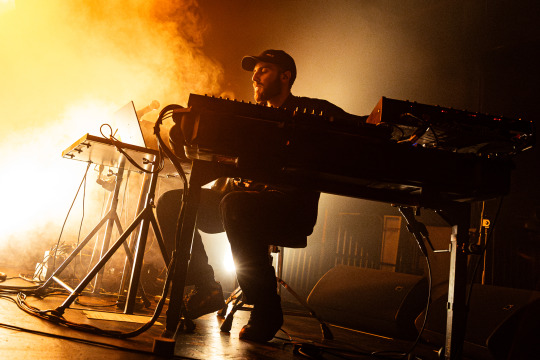
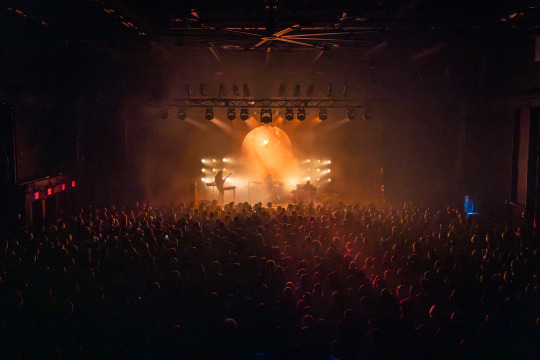
Together — barely visible, backlit in a mist — the trio used a big palette for their show: Choice pulls from all three Darkside albums in a setlist that was more a mélange than a sequence, and even a few cover sneaks, notably Sonny Bono’s “Bang Bang (My Baby Shot Me Down),” Harrington loving on the familiar deep-noir guitar intro and Jaar rendering the famous vocal line as an acid-blues. It was two hours that felt even fuller, with visits from dub (“Slau”), drum and bass, chrome-cold psychedelia, warmly-jam-band-y-choogle (“Are You Tired? (Keep On Singing)”) … the mind runs away with descriptors as the senses overload. —Chad Berndtson | @cberndtson
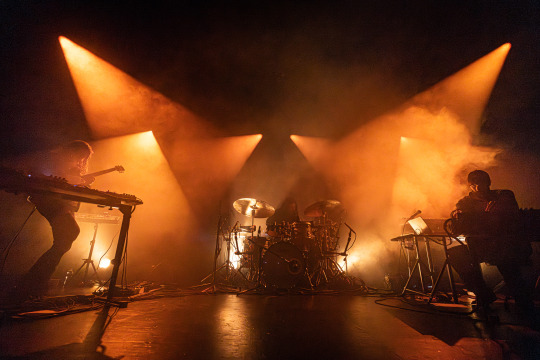
Photos courtesy of Ellen Qbertplaya | @qbertplaya
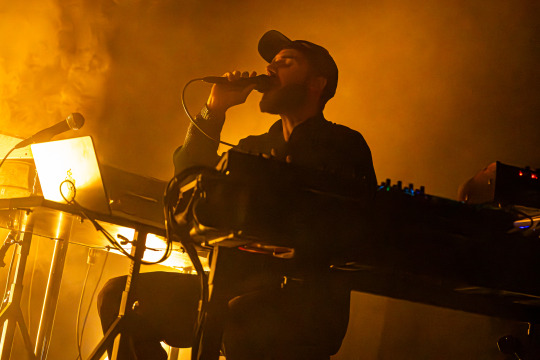
#Bowery Presents#Brooklyn#Brooklyn Steel#Bushwick#Darkside#Dave Harrington#East Williamsburg#Ellen Qbertplaya#Greenpoint#Live Music#Music#New York City#Nicolás Jaar#Nothing#Photos#Sonny Bono#Tlacael Esparza#Williamsburg
2 notes
·
View notes
Text
Music is an Essential Verb: Derek Taylor 2023
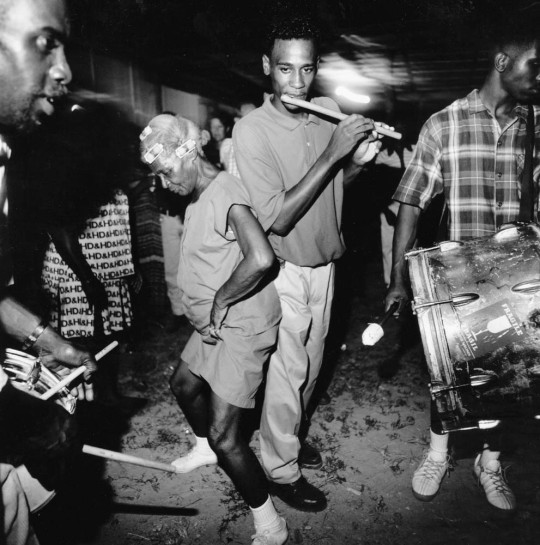
Music remains, along with family, friends, and a select few venial vices, my primary daily defense against the mental erosions of spiritual malaise and existential dread. Being a humanist also means being a realist, and little looks to be different on that score in the year ahead as we continue to careen toward a bleak and self-defeating dénouement. The veil of uncertainty around what ultimately feels like inevitability redoubles the need to remain thankful for and supportive of those who devote themselves to art. Summary capsules below describe some of the sounds that kept me going in 2023.
Peter Brötzmann, Wayne Shorter, Kidd Jordan, & Charles Gayle
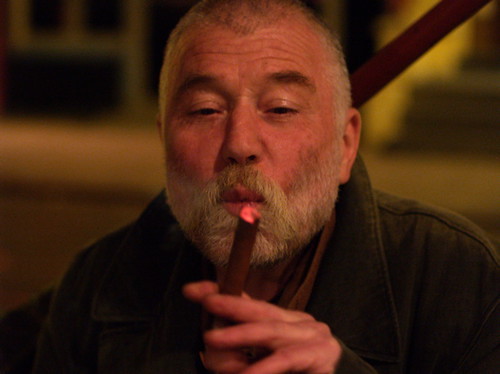
“The trauma of my generation was what our fathers had done to the rest of the world, and so we said, ‘never again,’ and that was the whole impetus through all my life, and it still is.” ~ Brötzmann (2018)
Musician attrition and demise are dispiriting aspects of every annum, but the departure of four disparate octogenarian reedists exacted an especially steep emotional and cultural toll this year. Shorter and Jordan passed away in March, each of them leaving a rich legacy as indefatigable improviser and altruistic educator that continue influence and inspire. Brötzmann exited in June after the return of a protracted respiratory illness. Few if any can match the magnitude of his mileage and six-decade itinerary as an irrepressible, obstinately adventurous world traveler. Gayle ascended in September, an ardent, uncompromising eremite to the end. All four men left behind discographies and concert/interview footage that will leave the faithful and curious listening and marveling in perpetuity, but their collective absence still aches.
Kirk Knuffke & Joe McPhee Quartet + 1 – Keep the Dream Up (Fundacja Sluchaj)
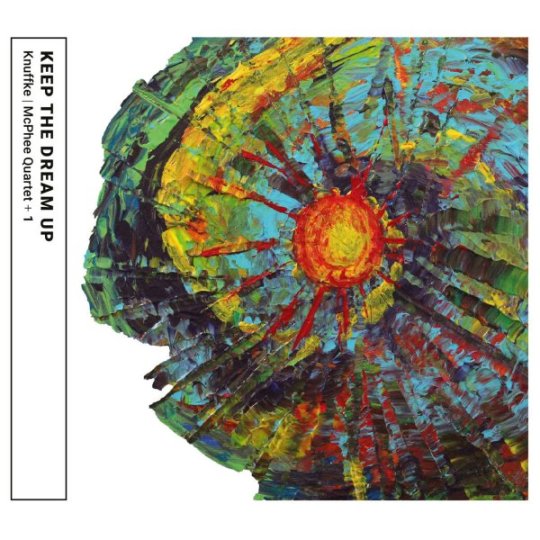
One of the manifold joys of following the output of Kirk Knuffke is anticipating who he’ll collaborate with next. The cornetist’s ears and imagination are as huge as his heart, a trait he has in common with the equally equanimous Joe McPhee. They’ve known each other for years but Keep the Dream Up is their first released collaboration and it’s an affirming alloy of their complementary creative temperaments. Longtime McPhee comrades Michael Bisio and Jay Rosen complete the quartet with bass clarinetist Christof Knoche comprising the additive on a Brooklyn studio session that captures collective creative lightning in a digital bottle. My album of the year for these reasons and more, although hopefully Joe will bring his brass to a follow-up conclave soon.
Don Byas – Classic Sessions 1944-1946 (Mosaic)
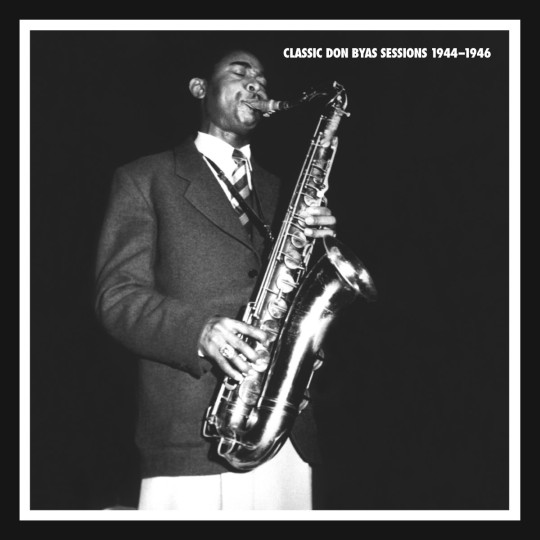
Saxophonist Don Byas recorded prolifically during the 1940s. His porous sound and popular style bridged the schools of swing and bop through prowess and panache aligned with the most esteemed of post-WII tone scientists. That sustained industriousness hasn’t reflected in reliable access to his works, primarily because they’re spread across a plethora of independent labels and competing copyrights. Leave it to Mosaic Records to rectify the longstanding reissue lacuna. This long gestating collection corrals and sequences the bulk of them across ten discs, scrubbing their sound, and adding an expansive cache of rarified verité concert recordings made in a Swedish jazz fan’s residence. Indulging in one’s Byas bias has never been easier or as edifying.
Fred Anderson – The Milwaukee Tapes Vol. 2 (Corbett vs Dempsey)
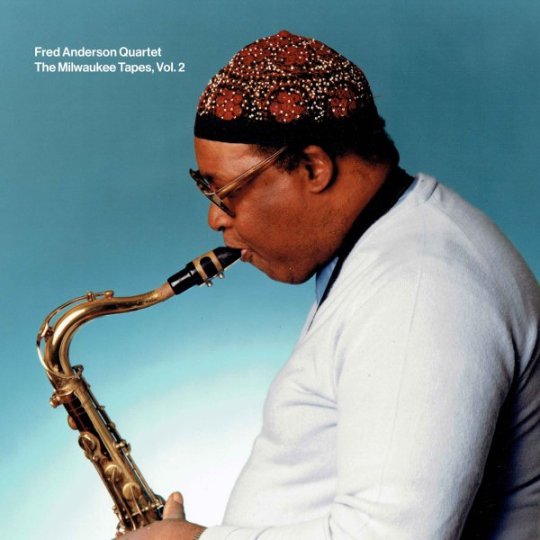
Patience and long-game aptitude are among music producer/archivist/advocate John Corbett’s virtues. This unexpected, but abundantly welcome sequel to an archival Anderson collection on Corbett’s long defunct Unheard Music Series took 23 years to secure commercial circulation and offers an additional hour-plus from the same gig in improved sound. Fellow AACMers Billy Brimfield and Hamid (nee Hank) Drake join bassist Larry Hayrod in bringing vibrant, detailed life to the Lone Prophet of the Prairie’s (as Anderson was affectionately known) serpentine, cerulean melodies. Corbett’s current label released a plenitude of music in 2023 (see also below) but the uncommon opportunity to hear more Anderson of any vintage makes this release worthy of independent mention.
Jason Adasiewicz
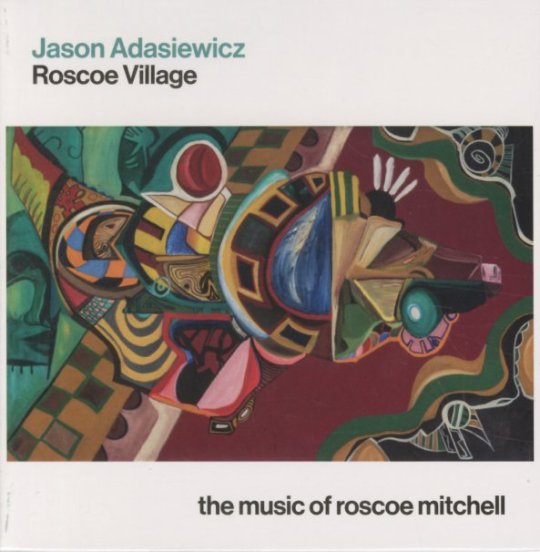
Corbett vs. Dempsey also had a welcome role in Jason Adasiewicz’s return to record with two different projects. On vinyl, Roy’s World documents a 2017 Chicago studio session by the vibraphonist’s quintet originally intended as the soundtrack to a film based on neo-noir novelist Barry Gifford’s short stories. Chicago stalwarts Josh Berman, Joshua Abrams, Hamid Drake, join saxophonist Jonathan Doyle in the ensemble for a program that sounds at once fresh and nostalgic while always vital. On CD, Roscoe’s Village dispenses with band for a solo selective foray through the songbook of Roscoe Mitchell including evocative renderings of “Congliptious” and “A Jackson in Your House” that retain the composer’s essence while striking out in bold new directions.
Natural Information Society

Grounded as it is in core voices of guembri, frame drum and harmonium, codification of Josh Abrams’ NIS as a jazz ensemble immediately feels reductively incomplete. All participating instruments can be active architects in the undulating, melody-laced drones that frequently form the basis of the band’s gradual, granulated improvisations. Performances are more akin to collective expeditions where a galvanizing gestalt effect is afoot; one where earned communal peaks preserve the individual power and agency of the interlocking parts. Since Time is Gravity augments this already catalytic template by incorporating a larger contingent of Chicago colleagues including tenorist Ari Brown to the equation.
Abdul Wadud
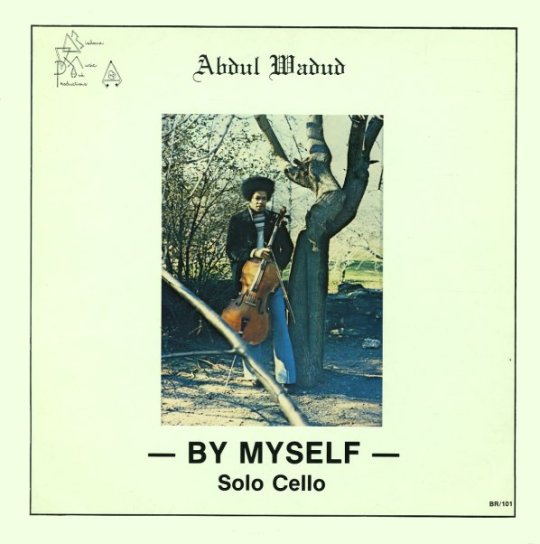
A jazz-based improviser on the cello who didn’t double on other stringed instruments, Wadud was also a consummate collaborator and sideman. Magnanimity in lending his substantial talents to the projects of others resulted in a paucity of albums under his own name. By Myself from 1977 on the Bisharra label is a revelatory anomaly on that self-effacing resume. Wadud approaches the instrument as a multifaceted sound factory, plucking, strumming, and bowing, often simultaneously, to create solo tone poems steeped in personal poignancy. Gotta Groove’s vinyl reissue is a beautiful facsimile of the original album object in faithfully reconstructed fidelity.
Marion Brown

Georgia-born altoist Marion Brown had a lengthy, storied career but the body of recorded work that he left behind can present difficulties in terms of ingress to its totality. Scattered across labels, years, and circumstances, much of it is either out of print or commercially unreleased. That collective relative obscurity makes a trio of releases, two on the German Moosicus label, and a third Record Store Day viny reissue of Brown’s 1970 studio duets with Wadada Leo Smith under the shared sobriquet Creative Improvisation Ensemble even more valuable. Of the former two, Mary Ann presents concert material by Brown’s quartet from a 1969 Bremen club gig in soundboard fidelity. Gesprächsfetzen & In Sommerhausen combines two more German concert snapshots, quintet, and sextet, from 1968 & 1969 with Gunter Hampel originally released on the Calig imprint. Steve McCall is a boon on drums in all three contexts.
Art Pepper – Complete Maiden Voyage Recordings (Omnivore)
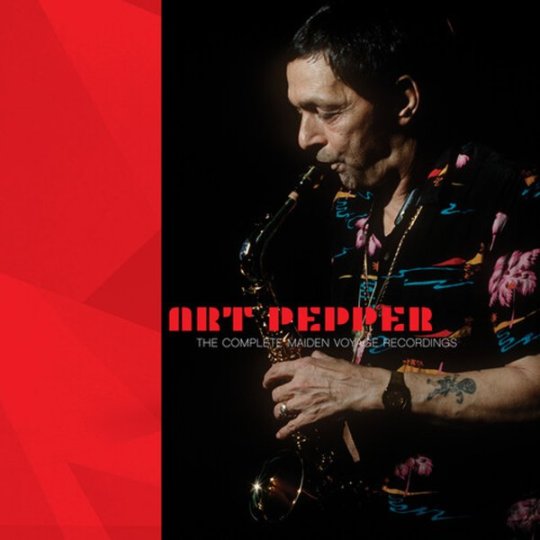
Art Pepper was an inveterate rake for most of his life, magnifying destructive interpersonal tendencies with drugs and frustratingly frequent acts of self-sabotage. That star-crossed propensity makes the fact that he left so much magnificent music even more miraculous. This lavish box is a fascinating compendium of the constantly competing artistic contradictions at his center, collecting a quartet gig across three nights and seven club sets in Pepper’s native Los Angeles, ten months prior to his premature passing at 56. Over half of the music is previously unreleased and the rhythm section, led by the impeccable and implacable pianistics of George Cables, gives Pepper a cumulative confidence boost that keeps him on the rails. None of it has ever sounded better.
Pan Afrikan People’s Arkestra
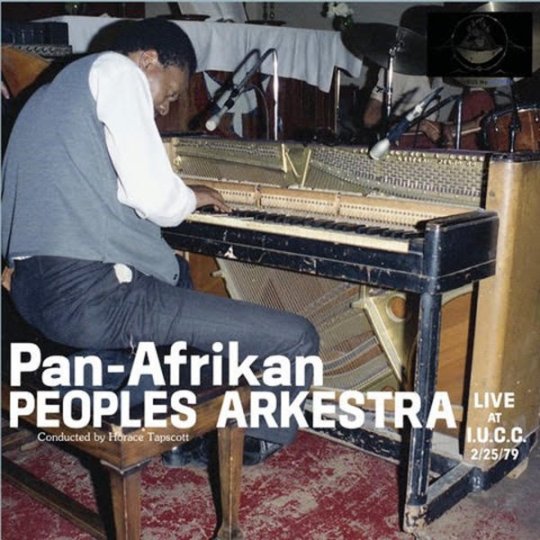
Los Angeles of the late-1970s was an unforgiving environment for the economic necessities of orchestral jazz. The Pan Afrikan People’s Arkestra, under the nominal leadership of pianist/composer/community organizer Horace Tapscott, was a tenaciously subversive force in the face of that ruinous rule. Adopting the Immanuel United Church of Christ as an informal base of operations, the large ensemble resourcefully engaged in an ambitious series of concerts in 1979. The Nimbus label, long a Tapscott exponent and repository, released the first three entries this year in an archival subscription series collecting the voluminous results. Titles are also available individually and present the pivotal band at a performative peak with star soloists Sabir Mateen, Billy Harris, Jesse Sharps, and Robert Miranda shining just as bright as their fearless foreman.
Alan Skidmore – A Supreme Love
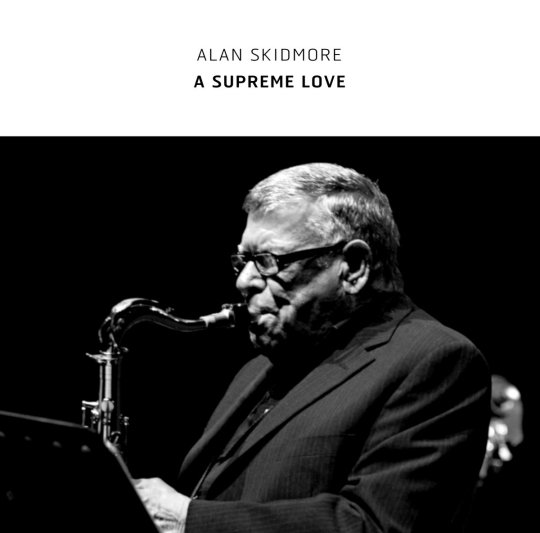
Unexpectedly issued on Mark Wastell’s Confront label, an imprint better known for its fealty to free improvisation, this six-disc archival tribute to Alan Skidmore’s 70+ year career in music launches with the saxophonist’s 1961 radio debut and lands some seven-hours later with his intimate 2019 rendering of John Coltrane’s “Psalm.” The aural expanse between is brimming with bright moments and luminary collaborators the likes of which include Tony Oxley, Kenny Wheeler, Wayne Shorter, Dave Holland, Mike Osborne, Elvin Jones, and another dozen name drops from the top tier of improvised music. It’s a wild, illuminating ride and a sterling example of a musical memorial done right.
The Jazz Doctors – Intensive Care/Prescriptions Filled: The Billy Bang Quartet Sessions 1983/1984 (Cadillac)

Billy Bang and Frank Lowe shared a bottomless fraternal bond forged through parallel traumas internalized in Vietnam and expressed by the subsequent embrace of the restorative power of improvised music. The pair of sessions (one reissued, one archival) collected on this disc epitomize their deep attachment arguably as well as any of their other numerous collaborations. Outside the cardinal duo, the Jazz Doctors never really had a stable lineup, but the quartets here embody two of their best. Both programs are loosely adherent to freebop conventions with violin and tenor saxophone combining over contrabass and drums for a potent front line. Bang and Lowe are long gone now, their shared absence making the availability of this music even more precious.
Attila Zoller & Jimmy Raney

Hungarian guitarist Attila Zoller had selective affinity for other artists on the instrument, so much so that his mid-career period is seeded by fateful encounters with plectrist peers. Most prolific among these partnerships was his prudent pairing with Jimmy Raney. A popular proponent of bop-based jazz, Raney was in a similar exploratory headspace when the two joined forces on a trio of recordings for the German L + R label over a seven-year span. Concert dates from Frankfurt (’80) and Berlin (’86) find the duo spooling out lengthy dialogues that dabble in free improvisation while keeping codified melodies within reach. An earlier New York encounter (’79) explores their rapport in a studio. All three reissues on the Japanese Ultra-Vybe imprint are aces.
Steve Swell’s Fire Into Music

Simultaneously emblematic of NYC free jazz in the early aughts and fiercely dedicated to resisting pitfalls of provincialism by touring generously and rigorously, trombonist Steve Swell’s Fire into Music was one of the finest quartets of its kind. Posthumously dedicated to the late altoist Moondoc, this three CD set collects a trio of small venue concerts by the band from gigs in Texas and Ontario. As with the horns, William Parker and Hamid Drake are ideally suited to the extended, expository freebop safaris that formed the ensemble’s flexible repertoire. Swell’s the leader on paper but sagely embraces musical communalism without fail.
Intakt

Running a physical media imprint in the 21st century is an inherently parlous enterprise, but this steadfast Swiss label continues to evidence how it’s done. This year’s standout catalog entries include Andrew Cyrille’s Music Delivery/Percussion, the octogenarian drummer’s third solo album and first in 45-years; bassist Jöelle Leandré’s solo Zurich Concert; pianist Aruán Ortiz’s Serranías Sketchbook for Piano Trio; Beyond Dragons by the trio of saxophonist Angelika Niescier, cellist Tomeka Reid, and drummer Savannah Harris, and Ohad Talmor’s Back to the Land, a quartet-plus-guests survey that takes its compositional focus an archival workshop date by Ornette Coleman and Lee Konitz.
Ezz-thetics

The appearance of the Swiss Ezz-thetics imprint four years ago raised both eyebrows and ire. Lacking access to master tapes, veteran free jazz and new music producer Werner Uehlinger sourced commercially released editions instead, employing ace audio engineer Peter Pfister succeeded by Michael Brandli to rejuvenate and refurbish the recordings, stateside copyright considerations be damned. Reaction was expeditious and polemical, but proof is in the hearing as most of the label’s dozens of releases sound better than their original incarnations. Catalog highlights this year include another round of Albert Ayler airshots including his pivotal meeting with the Cecil Tayor Trio in 1962 on More Lost Performances, Charles Mingus’ At Antibes 1960, and Ornette Coleman’s At the Golden Circle.
Fresh Sound

Jordi Pujol is akin to Uehlinger in that he refuses to let his vision and ambitions as a producer be abbreviated by external opinion. In Pujol’s case it’s yielded a bountiful inventory of antiquarian titles that rights holders have shown little to zero interest in restoring to begin with. Cases in point for this year include a definitive collection of obscurando saxophonist Boots Mussulli’s works; concert and studio collections by the Count Basie alumni tandem of Al Grey and Billy Mitchell; hens’ teeth rare leader sessions by Arthur Lyman vibraphonist Julius Wechter; and a two-fer of Julliard-trained Ellingtonian Cass Harrison piano trio albums. Exciting guilty pleasures all around.
Playing for the Man at the Door

As complex as he was controversial, Robert “Mack” McCormick deserves consideration in the esteemed company of other maverick cultural archivists like Alan Lomax, George Mitchell, and Harry Smith. With a preservationist purview mostly comprising Texas and bordering states, McCormick spent much of his adult life obsessively documenting and disentangling the cultural capital of the region through recordings, photography, interviews, essays, and research. Smithsonian Folkways became repository for the massive reservoir after his passing and this box is the first in what will hopefully be multiple dispatches from the same. Unreleased field recordings of Mance Lipscomb and Lightnin’ Hopkins represent the big names, but works by the likes of Hop Wilson, Cedell Davis, Robert Shaw, and a handful of others are just as persuasive. Bongo Joe Coleman’s impassioned presidential pitch closing the set will have listeners pining for a time when third party Executive Branch candidacy didn’t seem so fraught.
Joni Mitchell Archives - Vol. 3, The Asylum Years 1972 to 1975

Mitchell’s continuing project corollary to her old friend Neil Young’s analogously exhaustive retrospective enterprise, this third entry in the series finds her 30-something-self further broadening the lens of her art beyond the solo concert music that dominated the first two boxes. There are stirring solitary shows here, too, but it’s the band offerings that prove most revealing, particularly in the company of reedist Tom Scott’s fusion group L.A. Express. James Taylor, Graham Nash, and David Crosby lend contributory hands, and there’s a brief but intriguing collaboration with Young alongside a trove of demos and workshop versions of songs from her first three albums for Asylum.
Martin Davidson

In closing, another memorial. Martin Davidson wasn’t a musician, but European free improvisation as an art and archive would be a fraction of what it is without his copious and enduring work. As steadfast proprietor of the Emanem label he put his resources into musicians whose efforts frequently fell outside the probability of consistent commercial remuneration. Under his aegis, influential improvisers like Steve Lacy, Derek Bailey, Evan Parker, and Paul Rutherford gained robust catalogs alongside other aspiring artists who never garnered even niche cachet. Davidson was a curmudgeon and an anachronism, trusting his ears implicitly, suffering the indignities of inquiries from strangers seeking audience with the hip hop icon who shared the phonetics of his imprint’s name, and advancing the pleasures of physical media well past their purported expiration date. He was also a talented writer, adding invaluable context to his releases through first-person testimony and critique. Martin will be missed.
And as is tradition in this 20th iteration of this year-end exercise, 25 more titles in stochastic order. Thanks to all for reading, and gratitude to Jennifer Kelly for providing the forum and formatting.
Rodrigo Amado’s The Bridge – Beyond the Margins (Trost)
James Brandon Lewis – For Mahalia with Love (Tao Forms)
Henry Threadgill – The Other One (Pi)
Guillermo Gregorio – Two Trios (ESP)
Rob Brown – Oceanic (RogueArt)
Rich Halley Quintet – Fire Within (Pine Eagle)
Milford Graves w/ Arthur Doyle & Hugh Glover – Children of the Forest (Black Editions)
Mike Osborne – Starting Fires: Live at the 100 Club 1970 (British Progressive Jazz)
Jim Hall – Uniquities Vol 1 + 2 (ArtistShare)
Madhuvanti Pal – The Holy Mother (Sublime Frequencies)
V/A – On the Honky Tonk Highway with Augie Meyers & the Texas Re-Cord Company (Bear Family)
Mal Waldron & Terumasa Hino – Reminiscent Suite (Victor/BBE)
Oum Kalsoum – L’Astre D’Orient 1926-1937 (Fremeaux & Associates)
Sonny Rollins w/ the Heikki Sarmanto Trio – Live at Finlandia Hall Helsinki 1972 (Svart)
V/A – Equatoriana: El Universo Paralelo de Polibio Mayorga (Analog Africa)
Evan Parker – NYC 1978 (Relative Pitch)
V/A – If There’s a Hell Below (Numero Group)
John Coltrane – Evenings at the Village Gate (Impulse)
Derek Bailey & Paul Motian – Duo in Concert (Frozen Reeds)
Peter Brötzmann/Fred Van Hove/Han Bennink/Albert Mangelsdorff – Outspan 1 & 2 (FMP/Cien Fuegos)
Hasaan Ibn Ali – Reaching for the Stars: Trios/Duos/Solos (Omnivore)
Mark Dresser – Tines of Change (Pyroclastic)
Steve Millhouse – The Unwinding (Steeplechase)
Myra Melford’s Fire and Water Quintet – Hear the Light Singing (RogueArt)
V/A – Destination Desert: 33 Oriental Rock & Roll Treasures (Bear Family)
#dusted magazine#derek taylor#yearend 2023#Peter Brötzmann#Wayne Shorter#jazz#kidd jordan#charles gayle#kirk knuffle#joe mcphee#don byas#fred anderson#Jason Adasiewicz#natural information society#Abdul Wadud#marion brown#art pepper#Pan Afrikan People’s Arkestra#Alan Skidmore#The jazz doctors#Attila Zoller & Jimmy Raney
16 notes
·
View notes
Note
fic ask!! for passage commentary, this bit from "now I breathe flames every time I talk" chapter one (though the entirety of ch1 lives rent free in my mind at all times):
The thing is, she knows them too well. They all follow her to the bathroom—Oisin is with his great something grandmother tonight and Buddy doesn’t stay on weekends, so it’s Ruben, Ivy, and Mary Ann that stand at the end of the hall, watching to see what nefarious plan she’s got under her sleeve.
She uses her own toothpaste and her own toothbrush, doesn’t touch anyone else’s, and steps out into the hall. Three heads whip behind a corner; she pretends not to notice. There’s four guest rooms; on nights when everyone is staying, either someone pulls an all-nighter or someone ends up napping at their desk. It’s usually Kipperlilly that sacrifices the room. But again, Oisin isn’t here, and they agreed early in sophomore year that they wouldn’t mind letting her borrow his unofficial room when she needed it. It’s been a while, but she thinks the offer still stands. So into his room she goes, and there’s lots of papers regarding bank dealings and Adaine Abernant, but she ignores all of it and shuts the door so she can change.
Shadows pass in front of the door a few times as she gets ready, letting her hair down, avoiding looking in the mirror. When the light goes out, the movement stops, and she can picture them all on the other side. Let them wonder, she thinks. Let them stalk her. They don’t care about her and they never did, so—
She tries to sleep. Honestly, she does. But fifteen minutes later the door creaks open, letting light spill into the room. Kipperlilly doesn’t move. She’s not doing anything wrong, goddamn it, she’s just trying to fucking sleep.
OH I LOVED THIS SECTION <3
no because i'm sort of obsessed with the non rogues of the party trying to tail the actual rogue, especially when she's...not actually doing anything for once? like i wanted it to read like a brooklyn 99 scene for this whole sequence, where ruben&co think they're in the heist of the century trying to figure out what kipperlilly is doing...meanwhile kipperlilly is literally being the most normal she's ever been.
also confession time...i have the line in here about adaine and bank documents which in hindsight is so funny to me that people read it as oisin being the reason adaine is poor, because i actually meant for it to be "oh, oisin has something to do with the KVX bank turning blue, and as a separate fun fact he's been stalking adaine and trying to learn more about her. but i actually prefer the take that he's got something to do with adaine not getting money, because it makes him offering her components and gems and gold so much more sinister in context hahaha
but i also wanted to throw in the oisin and kipperlilly dynamic, because they're so fascinating to me. arguably they're the smartest in the crew—at the very least, they're the two most likely to be involved in the main plot, as shown by the buddy/last stand moment and the scene during rock the vote. (this is also coming into play in ch2 LOL so i'm glad i left the crumbs in ch1)
and then. and then!! kipperlilly just...sweet girl, she wouldn't even recognize if she saw herself in the mirror after the mask has dropped. it's the way she has completely detached herself from any of her actions and who she's become now, and she can't face it, so she just keeps plowing forward instead. like a sunk cost fallacy of "i've come this far, no use in reflecting on how i got here or where i came from or who i used to be" sort of thing. she tries so hard to pretend things are fine, it's just that...they're not. y'know?
thank you!!! for letting me get to analyze this, i fucking love it hehehe
#the box writes#d20 fhjy spoilers#inbox#kipperlilly copperkettle#now i breathe flames each time i talk
11 notes
·
View notes
Text












We cut to the trio exploring. They've found the kitchen but don't understand what things are about and cause shenanigans.
One of the things I find particularly interesting about this sequence is that once again, we have Brooklyn and Lexington on a sort of same page situation. They stick by each other. When brooklyn accidently starts the stove on his hand and jerks back, Lexington is right there to be knocked into the shelves of pans. They're exploring next to each other to just glance over when they hear Broadway call out.
But Broadway is off doing his own thing. He locates the cooler. Arguably, he's clued in on the most important part of the kitchen for them. It certainly catches his interest. It's definitely something worth calling out about ("Hey guys! I think I found the food!"), but he doesn't. I'm going to keep an eye on him to see if this comes from a place of selfishness or obliviousness. My gut is to say that he just doesn't think to call out. His interest is piqued, and he gets consumed by that interest. But also, maybe it's hard for him to feel like he's survived with two people his age who are closer to each other than to him. Maybe if they can have that closeness, he'll take what he can find where he finds it.
Either way, it doesn't stop him from immediately calling out when he finds himself trapped.
I know this whole sequence is a moment to keep kids interested in what's happening, to give them a moment of amusement in between the more serious stuff, but even little filler moments, maybes sometimes especially, have good character moments.
9 notes
·
View notes
Text
Last Monday of the Week 2023-11-27
Snow
Listening: Someone on IRC linked me to 3Blue1Brown's Hallelujah Parody about the vicissitudes of apparent patterns in sequences.
youtube
Reading: You Want My Password or a Dead Patient:, a paper about information security and the lack thereof in medical contexts. Paper linked here, but I first heard about it in this Choast.
A very good deep dive into the extremes of classic reasons why information security is bypassed: it's just much more important that you have access to resources Right Now in a hospital context than it is that they are secure against hacker, most of the time.
Hospitals process a lot of private information, so they are often beholden to the security standards imposed by regulations agencies. If you've engaged with mandatory security regulations you'll know a lot of them are, uh, bad?
(Famously if you want to meet US FIPS Government Standards you cannot use the Good Elliptic Curve ed25519 and instead you have to use a different, less well secured curve.)
Anyway what this means is that you have a significant conflict between the very high stakes and fast paced world of hospital medicine, and a system that wants you to log back in every time you step away from the x-ray machine.
Watching: Nothing.
Playing: As you may know if you're following me, I started Dark Souls this week. I am having a great time in Dark Souls! It's a lot of fun. I am still where I was yesterday, having just beaten the Belltower Gargoyles.
youtube
There are definitely notes that I have. It is for sure a 12 year old game. Some of the opacity is definitely intentional difficulty, like requiring you to just feel out the parry timing, but I it probably wouldn't make the game any easier if it had reliable indicators of when you're in position to backstab or riposte someone and it would make parrying much more fun. I like parrying but so often you parry someone and then just hit them normally instead of going for the cool finisher riposte.
Making: Like ten minutes ago I reopened Cinnabar and Calcite and did a little hardware swap, moving a new network card into Calcite and Calcite's old network card into Cinnabar. Everyone is settled back in. Wifi card upgrades are not really essential but it is nice to have wifi on a desktop even if you don't use it because a) someday you will and b) it's free bluetooth.
Also: Wrote some very bad bash to use my motherboard RGB as a tally light for recording these Dark Souls clips, since I've lost a few clips to hitting the wrong record button a few times.
Tools and Equipment: Original Tuesdayposter @girlfriendsofthegalaxy had a video on marinara sauce this last Tuesday and I was inspired to try some tomato pasta bakes. I usually make Mornay sauce based pasta bakes because it's what my parents usually made, but you gotta try a really spicy tomato pasta bake.
I got some habaneros and jalapenos from the farmers market and made a big pot of spicy tomato tuna bake and especially with the weather being How It Is that was great, I'm making a mushroom one sometime soon it kicked ass. That recipe was loosely based on this one, although I put in a bunch of extra vegetables.
11 notes
·
View notes
Text
The Hollywood Reporter
A Different Man’ Review: Sebastian Stan Drops the Mask in a Provocative Dark Comedy With a Heart0
Renate Reinsve ('The Worst Person in the World') and Adam Pearson ('Under the Skin') co-star in writer-director Aaron Schimberg’s twisted New York-set fable.
BY JORDAN MINTZER
JANUARY 21, 2024
Looks can be deceiving in A Different Man, writer-director Aaron Schimberg’s endearingly twisted take on actors, playwrights, egos and the plight of the profoundly disfigured.
Like the famous “Eye of the Beholder” episode of The Twilight Zone, in which humans turn out to be society’s freakish outcasts, this dark comedy suggests what happens when an aspiring thespian afflicted with neurofibromatosis manages to find a miracle cure, only to long for the life he had when he was still deformed.
The thesp in question — a nebbishy New York actor named Edward, or Ed — is played with tongue-in-cheek gravitas by Sebastian Stan, who dons several layers of prosthetics (courtesy of ace makeup designer Mike Marino) until peeling them away to reveal his true face. But that hardly gives Ed the life he bargained for, in a film that piquantly questions how others look at us and, more importantly, how we look at ourselves.
The fact that Pearson is stricken with neurofibromatosis, and that Stan wore tons of makeup to mimic that condition, may raise a few eyebrows. And yet A Different Man is very much about art imitating life and vice-versa, contemplating the different masks — whether real or artificial — we put on when going out into the world.
At first, the story plays out like your typical NYC indie dramedy, with Ed living in a grubby one-bedroom apartment in Brooklyn while trying to make it as an actor. He has a nosy super, at least one neighbor who hates him, and there’s a leak in his ceiling that grows so big it risks swallowing him up. The catch is that Ed’s disfigured state makes him completely stand out, at least to the viewer. For those who already know him, he comes across as just another shy and curmudgeonly New Yawka.
Things start looking up when a new neighbor, the radiant Ingrid (Renate Reinsve, The Worst Person in the World), moves in next door. Like Ed, she’s an aspiring artist — a playwright, in fact — and the two soon hit it off, even if Ed is very much inhibited by his looks. Ingrid is more open-minded and curious, and one novel aspect of Schimberg’s script is how, unlike in David Lynch’s The Elephant Man, nearly everyone Ed meets treats him with respect and compassion.
Schimberg explored a similar theme, albeit in a more artsy fashion, in his 2018 behind-the-scenes drama Chained for Life. That film co-starred Adam Pearson, who many may remember from his haunting sequence opposite Scarlett Johansson in Jonathan Glazer’s Under the Skin, and who winds up stealing the show here as a totally charming and nonchalant threat to Ed’s newfound existence.
The failing actor’s humdrum life takes a major turn when he agrees to participate in an experimental drug program that could cure his condition. After several scenes of Cronenberg-esque body horror, he starts peeling away his tumors like a snake shedding its skin, transforming into a brand new person with Stan’s well-defined face.
You would think this would all be for the better, but as A Different Man goes on to reveal, things actually get worse. Ed soon comes to miss the man he once was, especially when Pearson’s character steps into the picture and very casually hijacks his life, including Ed’s burgeoning love affair with Ingrid.
That and other plot mechanics in Schimberg’s screenplay can seem a bit over-the-top, particularly when Ed begins to lose his mind in the third act as everything unravels. Still, the story’s twists and turns maintain our interest throughout, with the narrative taking on a cleverly deconstructed play-within-a-film format reminiscent, at times, of Charlie Kaufman’s Synecdoche, New York.
The antics are captured in grainy naturalistic visuals by Wyatt Garfield (The Kitchen) and backed by a score from Umberto Smerilli that shifts between indie vibes and the classic melodies of Hollywood B-flicks. A Different Man shifts between several genres as well, but Schimberg manages to tie things neatly together by asking the same question, in various ways, until the very last scene: What’s in a face?
3 notes
·
View notes
Text
Recently Viewed: Door
[The following review contains SPOILERS; YOU HAVE BEEN WARNED!]

When I first discovered the existence of Banmei Takahashi’s Door earlier this year (via various clips shared by fan accounts on Twitter), it was love at first sight. Luckily, while the movie currently lacks official distribution in the United States, I didn’t need to wait very long at all to see it (compared to Angel’s Egg, A Page of Madness, and Samurai Wolf, anyway) thanks to the Brooklyn Horror Film Festival, which screened it just before midnight on Friday, October 13th—basically the ideal context in which to experience its unique brand of madness.
The premise is as brilliant as it is straightforward: an ordinary housewife—already fed up with cold callers and their seemingly unlimited access to her family’s personal information—aggressively turns away an especially persistent salesman, slamming the door on his fingers after he ignores her repeated protests and attempts to force his way into her apartment. Unfortunately, this moment of instinctive panic has severe repercussions, resulting in an excruciatingly tense game of cat-and-mouse as the slighted pamphlet pusher’s vengeful wrath gradually evolves into perverse sexual obsession.

It’s a captivatingly mundane flavor of terror, twisting a familiar, relatable scenario into an inescapable nightmare. There’s nothing particularly memorable or remarkable about the central villain. He has no elaborate costume or mask, no supernatural abilities or distinguishing features; unlike Jason Voorhees, Michael Myers, and Leatherface, he doesn’t even wield a signature weapon (though he is quite handy with the absurdly convenient electric chainsaw that he scavenges from the protagonist’s collection of otherwise run-of-the-mill home appliances). This anonymity is absolutely chilling; he effortlessly blends in with the crowd—average, unassuming, invisible. Indeed, his façade of superficial “normalcy” is far more insidious than any explicit display of insanity; he taunts his prey with idle banter, seamlessly transitioning between casual flirtation and thinly veiled threats.
The director’s visual style perfectly complements the suspenseful tone of the narrative. Early scenes almost resemble a slice-of-life domestic drama, characterized by flat compositions and lighting. As the conflict escalates, however, the warm, inviting interiors slowly warp and distort, becoming cramped, claustrophobic, hostile. Foreground elements (potted plants, sculptures, windows, doorways) isolate our heroine within the frame, emphasizing her vulnerability. Voyeuristic point-of-view shots serve a similar purpose, subliminally insinuating that true “safety” is an illusion: the sinister stalker could be lurking around any shadowy corner. The increasingly maximalist cinematography culminates in the film’s most iconic sequence: a prolonged overhead angle that follows the now totally unhinged maniac as he relentlessly pursues his quarry from room to room, utterly demolishing every obstacle in his path—splintering wood, shattering glass, and reducing drywall to dust.

Yet some of the movie’s most haunting images are significantly less spectacular than this climactic set piece. Takahashi understands the inherent value of patience, frequently locking down the camera and lingering on long, uninterrupted closeups of his lead actress simply reacting to suspicious offscreen noises—the echo of footsteps in the corridor, for example, or the telltale rattle of the deadbolt being tested. Keiko Takahashi’s face is breathtakingly expressive; her turbulent emotions are palpable, a violent maelstrom of anxiety, desperation, and paralyzing fear clearly evident in every twitch of her eye, every crease in her brow, every tear staining her cheek.
How thematically appropriate that Door—a story that explores such everyday horrors as rampant commercialism, predatory marketing, and the erosion of privacy—should be at its scariest when it embraces naturalism, minimalism, and subtlety.
#Door#Banmei Takahashi#Keiko Takahashi#Japanese film#Japanese cinema#Japanese horror#J horror#Brooklyn Horror Film Festival#Arrow Video#Nitehawk Cinema#horror#Halloween 2023#film#writing#movie review
7 notes
·
View notes
Text

FLP CHAPBOOK OF THE DAY: Everything is a Big Deal for an Ocean by Susan Bruce
On SALE now! Pre-order Price Guarantee: https://www.finishinglinepress.com/product/everything-is-a-big-deal-for-an-ocean-by-susan-bruce/
In turbulent 2020, a year of isolation, the author stands on the shoreline of the #Atlantic Ocean in Montauk, LI and determines each of the waves to be unique, and selves of herself. Everything Is a Big Deal for an Ocean is the imagined poetic exchange between a vast #ocean and a tender writer, as they contend with intrinsic restlessness and connectedness. #poetry #poems #chapbook
Susan Bruce received an MA from NYU Tisch School of the Arts and a BA from the University of Michigan. She lives with her husband and their two sons in Brooklyn, where she grew up and in Montauk, NY where she surfs.
PRAISE FOR Everything is a Big Deal for an Ocean by Susan Bruce
Susan Bruce has written a contemporary voice for the voice of waves: humorous, besieged, beseeching. One wave is known as “the comedian of icy coldness”; one lets off steam “and ejaculates more waves”; another aspires “to be a skyscraper”; Everything Is a Big Deal for an Ocean is an elliptical dadaist re-invention of the life and times of waves, here perceived as individual entities with fears, wit, and desires of their own. Bruce has given waves both individual and multiple consciousness, inviting us to reconsider our love and fear of this force of nature. I couldn’t help but think of JMW Turner’s magisterial paintings: what if those waves could talk! Here we overhear the absolutely unpredictable, wholly original conversation between a writer in the sands and the insouciant waves.
–Catherine Barnett, author of Human Hours
Everything is a big deal, especially when you are an ocean full of waves. Bruce’s collection of poems in Everything is a Big Deal for an Ocean inhabits the spirit of being a wave, and a person and a waveperson. The poet is wave, and the wave is a poet who crashes and softens in the spirit of As a wave artist I sprinkle cells of splash. These poems are the power of splash, the sweetness of splash, the inside of a wave and the outside of a wave, a singular vision of the sea in all of its humanity. Everything is a huge deal, a monumental occasion that Bruce has written about through the lens of a wave that is never ending, the embattled and beautiful energy of everyday existence.
–Matthew Lippman, author of We Are All Sleeping with Our Sneakers On
What a surprising, witty, sensual, playful and compelling sequence of poems Susan Bruce has made. What a mind this ocean is—fluid, hypnotic—with its deeply improvisatory logic, its incessant questions, confessions, repetitions; its waves of thought and sinking feelings, its blues and cluttered ribcage. With a light touch and rhythmic beauty, a Yes, and process of investigation, Bruce explores our contradictions and compulsions, our fears and psychic undertows, in a moving lyric meditation on order and disorder.
–Donna Masini, author of 4:30 Movie
Everything Is a Big Deal for An Ocean is like standing on the shore, eavesdropping on an incredibly personal conversation between the narrator and the ocean. We’re lulled, then tossed by the sway of the waves, feel the grit of the sand between our toes, and hear the “growl and burst” resonating our ears. Who is speaking and whether the questions posed will ever be answered mirror the fluid, enigmatic nature of the water itself. In this dialogue, Bruce illuminates both the vast expanse of the ocean as well as the depths of our own internal worlds.
–Heather Aimee O’Neill, author of Memory Future and Obliterations
In Everything is a Big Deal for an Ocean, Susan Bruce connects the world of the writer, and the role of the writer, to that of the natural world. “We could be blissful together.” “I’m left to sing when the sun rises and sing when the sun sets.” That’s the call of the artist, isn’t it? To sing! The beauty of poetry is how we use it to be resilient. These poems make us think and help us to carry on, naturally, as a wave.
–Leah Umansky, author of Of Tyrant (2024)
Please share/please repost
#flpauthor #preorder #AwesomeCoverArt #poetry #chapbook #read #poems
1 note
·
View note
Text
Rediscovering a Cinematic Classic: The French Connection Retrospective

When film enthusiasts talk about gritty crime thrillers that have shaped the genre, “The French Connection” often stands at the forefront. This iconic 1971 film, directed by William Friedkin and based on a true story, remains a landmark in cinema history. A retrospective look at The French Connection reveals not just a film, but a cultural moment that redefined storytelling, editing, and realism in Hollywood.
A Breakthrough in Crime Cinema Released during a time when Hollywood was transitioning from the glossy films of the french connection retrospective to more raw and realistic narratives, The French Connection took audiences by storm. It starred Gene Hackman as the relentless and morally ambiguous detective Jimmy "Popeye" Doyle, and Roy Scheider as his partner, Buddy Russo. Their mission? To uncover and dismantle a heroin smuggling ring operating between France and the United States.
The film’s gritty atmosphere, handheld camera work, and unsentimental tone were revolutionary for the era. It was one of the first American films to adopt a documentary-like style, blending fact and fiction in a way that felt authentic. The New York City depicted in the film was far from the glamorous metropolis often seen in movies; instead, it was cold, dirty, and unforgiving — a perfect mirror for Doyle’s obsessive pursuit of justice.
The Infamous Car Chase No retrospective of The French Connection would be complete without a deep dive into its legendary car chase sequence. Shot under real New York traffic conditions and without extensive permits, the chase is still regarded as one of the most thrilling and realistic ever captured on film. Doyle races through the streets of Brooklyn in pursuit of an elevated train, with the camera mounted inside the car to immerse viewers in the chaotic action.
What makes this sequence stand out, even decades later, is its raw, unscripted energy. Friedkin used actual stunt drivers and even civilians who weren’t aware they were part of a movie — something that would be impossible today due to safety regulations. The result is a visceral, heart-pounding scene that set the standard for car chases in cinema.
Gene Hackman’s Defining Role Gene Hackman’s portrayal of Jimmy Doyle earned him an Academy Award for Best Actor, and for good reason. Doyle is a complex character — racist, volatile, and stubborn — yet somehow, Hackman made him compelling. He wasn't a clean-cut hero, but rather a flawed man doing what he believed was right in a world full of corruption.
This complexity was unusual for the time, especially in police dramas, where characters often followed a rigid moral compass. Doyle’s ambiguous ethics and personal demons added a layer of realism and unpredictability to the narrative, making The French Connection more than just another crime movie.
Realism Rooted in True Events One of the film’s greatest strengths lies in its foundation in real events. Based on the true story of New York detectives Eddie Egan and Sonny Grosso (who even appeared in the film), The French Connection wasn’t just inspired by reality — it was steeped in it. The screenplay, written by Ernest Tidyman, captured the essence of the original investigation while dramatizing key events for maximum impact.
This blending of reality and fiction brought a sense of urgency and credibility that helped it stand out in a crowded field of crime thrillers. It wasn’t about glamorizing the police or demonizing criminals — it was about showing the gritty, morally gray world in which law enforcement often operates.
Lasting Influence and Legacy The French Connection didn’t just win five Academy Awards, including Best Picture, Best Director, and Best Adapted Screenplay — it changed the way crime stories were told on screen. It opened the door for a new wave of American filmmaking that embraced realism, flawed characters, and a more cynical view of justice.
Its influence can be seen in later films like Serpico, Taxi Driver, and even modern-day series like The Wire. The film’s visual style, tone, and narrative approach have echoed across decades, inspiring filmmakers to challenge conventions and embrace authenticity.
A Retrospective Worth Revisiting As we look back on The French Connection through a modern lens, it remains just as powerful and relevant as it was over fifty years ago. In an age of CGI-heavy spectacles and formulaic storytelling, the film’s raw energy, unflinching realism, and bold direction serve as a reminder of the power of cinema to provoke, challenge, and thrill.
For those discovering it for the first time, or revisiting it with fresh eyes, The French Connection offers more than nostalgia — it offers a masterclass in filmmaking. A true classic that refuses to age, it stands as a testament to a time when Hollywood took risks and reaped the artistic rewards.
0 notes
Link
#anna.majcherczyk#atlas_samantha#bkchamberorch#brooklynheightslife#connormik_#dirigentnyc#gracechorale#its.evading#j.l._espinosa#meadwitterschoolofmusic#newyorkchoralsociety#Openingnight.Reviews#stannsbrooklyn#theFrontRowNYC
0 notes
Text

The making of "The French Connection" is as thrilling as the iconic 1971 film itself, a gritty crime drama that redefined how stories about law enforcement could be told on the big screen. Directed by William Friedkin and starring Gene Hackman as the relentless New York City cop Popeye Doyle, the film broke new ground in cinematography, storytelling, and action sequences. While the movie's gripping narrative and raw performances captivated audiences, its behind-the-scenes story reveals an equally fascinating tale of innovation, risk-taking, and intense collaboration.
One of the most striking aspects of "The French Connection" is its legendary car chase, which has been hailed as one of the most realistic and exhilarating sequences ever put to film. Friedkin's vision for the chase was not just to entertain but to immerse viewers in the visceral chaos of the moment. The director was insistent on filming the sequence in real locations, often without official permits. Stunt driver Bill Hickman, who played a pivotal role in executing the sequence, described the intensity of the shoot:
"We were driving at speeds close to 90 miles an hour through Brooklyn streets, with no rehearsals, no second takes. The pedestrians you see are real people who had no idea what was happening. It was a constant adrenaline rush, and there was always a risk of something going terribly wrong. But William trusted us to make it authentic, and that’s what we delivered."
Hackman, who had never driven in such extreme conditions, was also involved in some of the shots, adding an extra layer of realism to the chase. The actors and crew knew the risks involved but shared a commitment to pushing boundaries for the sake of authenticity.
The gritty realism of the film wasn’t limited to the car chase. Friedkin's dedication to capturing the raw essence of New York City in the 1970s meant working in some of the city's roughest neighborhoods. The director often relied on real-life criminals and ex-cops as extras to heighten the film’s authenticity. Sonny Grosso, a former NYPD detective and one of the inspirations for the film, worked closely with the cast to ensure the portrayal of police work was accurate. Grosso later recalled:
"Gene Hackman was so determined to understand the mindset of a cop like Popeye Doyle. He spent hours riding along with us, learning our mannerisms, our language, even our frustrations. He didn’t just act the part; he became Doyle. It wasn’t always easy for him, especially because he wasn’t comfortable with some of the darker aspects of the character, but his dedication paid off."
Hackman himself admitted that embodying Doyle was a challenge, as the character's aggressive and morally ambiguous nature often clashed with his personal values. Friedkin, however, pushed Hackman to embrace Doyle's flaws, believing that these nuances would make the character more compelling. The director later remarked:
"I told Gene, ‘You don’t have to like Doyle, but you have to understand him. He’s not a hero in the traditional sense. He’s flawed, driven, and often reckless, but that’s what makes him human. If you can tap into that, the audience will feel it too.’ Watching him evolve into that character was one of the most rewarding experiences of my career."
The collaborative yet intense working relationship between Friedkin and Hackman was mirrored throughout the production. Cinematographer Owen Roizman played a crucial role in bringing Friedkin’s vision to life, employing innovative techniques to create the film’s gritty, documentary-style aesthetic. Roizman used handheld cameras and natural lighting to capture the unvarnished reality of New York City, a decision that added to the film’s raw intensity. Roizman explained his approach in an interview:
"The goal was to make the audience feel like they were right there on the streets, experiencing the action firsthand. We didn’t want anything to feel staged or artificial. It was about finding the beauty in the imperfections and letting the environment dictate how we shot each scene. That freedom to experiment was what made the process so exciting."
The film’s commitment to authenticity extended to its dialogue and interactions. Much of the script was influenced by real-life events and conversations, with Friedkin encouraging improvisation to capture the unpredictable nature of human behavior. This approach created some of the film’s most memorable moments, including Doyle’s iconic interrogation scene. Actor Roy Scheider, who played Doyle’s partner, Buddy Russo, reflected on the dynamic energy on set:
"Bill had this ability to create an environment where everyone felt they could take risks. He trusted us to explore the characters and the scenes in a way that felt natural. That’s why the film resonates so deeply—it’s not polished; it’s alive. You can feel the tension, the unpredictability, because it’s real."
The grueling schedule and physical demands of the shoot tested the cast and crew, but the camaraderie that developed during production helped them persevere. Hackman, who initially struggled with the role, found support from his co-stars and the crew, many of whom admired his dedication. Reflecting on the experience years later, Hackman shared:
"Making 'The French Connection' was one of the hardest things I’ve ever done, both physically and emotionally. There were days when I wanted to walk away because it was just so intense. But at the same time, it was one of the most rewarding projects I’ve ever been a part of. It taught me to trust my instincts and to embrace the challenges that come with taking on a complex character."
When "The French Connection" was released, it became an instant classic, earning five Academy Awards, including Best Picture, Best Director, and Best Actor for Hackman. The film’s success was a testament to the risks and sacrifices made by everyone involved. Its legacy endures not just because of its groundbreaking storytelling but because of the passion and authenticity that defined its creation. As Friedkin once summed up:
"This wasn’t just a movie for us; it was an exploration of what cinema could be—raw, unfiltered, and unrelenting. We didn’t play it safe, and that’s why it still resonates today. Every frame, every scene, is a reflection of the blood, sweat, and tears we poured into it."
1 note
·
View note
Text
GCW You Wouldn't Understand 2024 Live Impressions

If we accept professional wrestling as a form of pantomime, then it certainly makes sense that you can feel the emotions of professional wrestling more directly live and in person than by watching on television. So, though GCW is not my preferred professional wrestling company, I went to their latest show at Brooklyn's Roulette Intermedium, You Wouldn't Understand, since it was a fairly affordable ticket ($54 for first row balcony reserved) and accessible (close to the Atlantic Avenue-Barclays Center hub).
Credit goes to GCW for cultivating an atmosphere that 1. replicates the atmosphere from old Chikara shows that I attended, where fans would wave to other fans that they had seen at other shows 2. is decidedly closer to 50/50 between men and women attendees 3. had a surprising number of young fans in attendance despite the flying profanity and the violence inherent to the show.
Independent wrestling merchandise, as always, remains a mixed bag at best. I was hopeful that UltraMantis Black and the Spectral Envoy might have apparel that I wouldn't be too embarrassed to wear, but I couldn't even find their stand before or after the show.
1. Brandon Kirk d. Bam Sullivan
Right off the bat, we are treated to plunder and excess as Bam Sullivan tries to prove his mettle to the GCW locker room by resurrecting Joey Ryan's groin-based offense. At least Sullivan is assaulting his opponent's groin and not forcing his opponents to touch his groin; nonetheless, I didn't think groin-based gimmicks, especially in a company that is open to intergender matches, survived Speaking Out. Bam Sullivan proved me wrong on that. Sullivan is a local act, so the obnoxiously loud fans to my right were happy to riff about Sullivan's mustache (another echo of Joey Ryan). To prove that he is a worthwhile addition to the GCW roster, Sullivan summoned chairs and doors from under the ring because that's what GCW's and Sullivan's limited definition of hardcore wrestling is. I wonder if the two deathmatch veterans used chairs and doors so early to compensate for the blood ban in New York.
Sullivan and Kirk started with a lot of energy, and things were fine until Sullivan either tired or lost focus and was slightly off his timing on some of the sequences with Kirk. Kirk beat Sullivan with a Psycho Driver and then indeed endorsed Sullivan as a worthy member of the roster. I wish someone had jumped Sullivan after that, but I suppose GCW has time later to tell the story that not everyone agrees that Sullivan belongs in GCW. For what it's worth, Sullivan fits the aesthetic and the working standard in GCW about as well as Kirk.
2. Brooke Havok d. Zayda Steel
Havok is 25 years old and has wrestled 136 matches in 3 years. Steel is 21 years old and has 113 matches in 2 years. With those caveats, I am willing to grade this on a curve because this was a mess. Havok struggled to lift Steel at various points during the match and had to repeat two spots twice. Havok and Steel couldn't quite rotate fully on a poisonrana, and they landed awkwardly. Their strikes looked unconvincing, and Steel's lungblower on Havok, who was suspended on the middle rope, makes no sense as a move in an ostensible fight. Steel, the WWE ID signee, seems more polished than Havok, even though her character is fairly shallow. Steel set up Havok for an Unprettier that looked tentative, but Havok squirmed free and pinned Steel to end the match. I suppose that means that being a WWE ID signee doesn't restrict you from losing matches, for now.
At this point, I was not impressed by the show or the fact that the venue was, at best, 2/3 full.
3. Tony Deppen d. Man Like DeReiss
I had last seen DeReiss at DEFY Can't Deny It, where he teamed with Michael Oku against the Bollywood Boyz, so I was looking forward to seeing how much he had progressed in those seven intervening months. He's certainly still energetic and charismatic, which made for an interesting contrast with Deppen, who has a deceptively dirtbag charm to his character and his wrestling style. Watching this, I felt like both Deppen and DeReiss could do better than wrestling undercard matches in a small GCW show in Brooklyn. Deppen should be able to reach at least the heights that Jimmy Rave reached at his peak in ROH.
DeReiss, the younger of the two, has more time to put it together. His sequence of rapping on the mic while hitting Deppen with shoulder tackle, chops, and clotheslines was fun if incomprehensible. It seemed like his focus during this match was to sell the arm that Deppen targeted and to find a way to channel the crowd's sympathy. On the first count, DeReiss was mostly successful; I don't understand why he would try to force Deppen to submit to a Stepover Toehold Facelock and not have his damaged arm come into play there or how his hurt arm slowed his climb to the top rope for a double stomp, but I appreciate how he would grimace and shake his arm every now and then. I'm not sure how well DeReiss succeeded on the second front; the crowd seemed to be more against Deppen, and eventually Griffin McCoy, than for DeReiss. I chalk that up to how the GCW crowd seems to go to shows to see GCW wrestlers, not to see wrestling in general, which I'll explore more later.
I hate the wrestling trope that a match's babyface must be completely flustered when someone appears ringside. DeReiss was set to finish Deppen with his 450 splash when Griffin McCoy appeared and taunted DeReiss from the stage. It's contrived nonsense.
After the match, Deppen pretended he had nothing to do with McCoy and left the ringside area. McCoy and DeReiss traded blows, and McCoy disabled DeReiss with a lowblow that looked like it took two attempts to hit. McCoy's opponent this evening, Grim Reefer, emerged to confront McCoy to let DeReiss leave.
4. Griffin McCoy d. Grim Reefer
I enjoyed Grim Reefer's work the last time I saw him live, which was 16 years ago at Jersey All Pro Wrestling's Reclaiming Hudson show on January 19, 2008. Reefer's gained some weight, slowed down a little, and doesn't fly from the top rope as much now, but he still seemed like a solid pro. The crowd, as it is wont to do, had fun punning off of Reefer's name with "Reefer's gonna smoke you" and "Light him up" chants to taunt McCoy. Reefer lit his joint and started smoking it while fighting McCoy, and the scent of weed wafted to the balcony. The crowd, of course, then chanted "Pass that shit."
McCoy's own scumbag charm was also great, and he reminded me of Austin Theory from Theory's Evolve run. I think there's potential there as a braggadocious heel who talks too much during the match but has the mettle to back it up when he's forced to do so. He doesn't have Theory's athleticism, but he's more entertaining and less off-putting than Theory was. It makes a ton of sense that McCoy was trained by the aforementioned Jimmy Rave at one point.
After the match, which McCoy won with a cheap pin, McCoy and Deppen beat up Reefer. DeReiss saved Reefer and called for Reefer to help hit Deppen with a 3-D for some reason. McCoy pulled Deppen to safety.
At this point, I felt like the show had gotten its feet under it after an uninspired start.
5. Matt Tremont d. Lou Nixon
In this match, the show lost whatever momentum it had been able to build. Tremont and Nixon decided to pay homage to Don Frye and Yoshihiro Takayama and missed the reason why Frye and Takayama's fight is so memorable: the respect that Frye and Takayama had, the position that they were in (as the last fight in a show that had largely underwhelmed, Frye and Takayama wanted to give the crowd a show), and the intensity of their violence (Frye and Takayama exchanged 137 punches in about 90 seconds). Instead, Tremont and Nixon exchanged some light punches, brawled to the floor, had Nixon hit Tremont with some kicks, and then Tremont hit a Death Valley Driver to win the match. An utterly pointless match that could have been replaced with a match featuring wrestlers from DEFY and PROGRESS's afternoon show. Tremont then told everyone that he and Nixon were paying homage to Frye and Takayama (poorly).
6. Allie Katch d. Microman
Katch and GCW promoter Brett Lauderdale clearly don't believe in wasting a crisis since they had Katch address how Effy's comments about Shad and Tony Khan likely caused AEW to pull Ricky Starks from all future GCW shows. I had said earlier that GCW fans attend GCW shows to see GCW wrestlers, but I'm not convinced that they care about the top level story that GCW is trying to tell with Katch, Effy, and Mance Warner. It didn't help that Katch talked for longer than she needed to for her point to be made. (I accept the irony in my writing this.)
On the other hand, the crowd loved Microman. So, when Katch gets booed for throwing Microman around, she can claim that the crowd is booing her character and the character's role in the story they're trying to weave. I don't think the investment was there from tonight's crowd; instead, I think the sentiment is for Microman more than it's against her. Using power wrestler moves like Mark Henry's World Strongest Slam and Yokozuna's corner Bonzai drop against Microman is a nice touch.
It was amusing when Katch tried to hit Microman with a running butt splash in the corner but missed him completely because he was too short.
For some reason, Blake Christian came out from under the ring and threatened Microman before deciding to leave him alone.
7. Megan Bayne vs. Parrow - No contest
I hadn't seen Parrow since he invaded Evolve with his partner in The End, Odinson, and forced us to listen to atrocious heavy metal music for minutes at a time while they fought the WorkHorsemen, Catch Point, and the Skulk. I guess he's a creep who likes to beat up women now in GCW. Bayne, after finishing her tour in Stardom, has been working primarily in Limitless, GCW, and Beyond, and it's a mystery why she's there instead of elsewhere. Bayne struggled to lift Parrow for the F-5 and messily dropped him in the execution. Parrow used a variety of power moves against her, which made sense since he dwarfed Bayne. Parrow was about to finish Bayne with a chokeslam, but the lights went out, and the supposedly criminally insane Charles Mason replaced Bayne in the chokeslam hold. I don't understand how that makes sense, where Bayne went, and what the deal with Bayne is.
8. Luke Jacobs d. 1 Called Manders
The show needed a good match after the stretch from Tremont vs. Nixon to Bayne vs. Parrow, and luckily Jacobs and Manders were able to deliver a thrilling fight to save the show for me. It was also apparent that no one knew who Luke Jacobs was; I was the only person cheering for him, and the crowd was oddly silent even though Manders and Jacobs worked very hard to get the crowd to notice. Manders and Jacobs had extended chop, forearm, lariat, and headbutt exchanges. It's not as if the crowd booed Jacobs and cheered Manders; they simply didn't seem to care about this unannounced match. I also don't understand the business logic of not announcing this match; given the 1/3 empty seats at the Roulette Intermedium on this Black Friday show, one could reasonably conclude that the announced matches weren't enough to entice potential attendees. Jacobs and Manders traded one-counts after lariats because they're both tough bastards; I enjoyed Jacobs calling Manders "a big bastard" while fighting to lift him up for a German suplex. They were tough bastards to the end as Manders refused to give up in Jacobs's rear-naked choke, raised a middle finger in defiance, and passed out to give Jacobs the win.
GCW, meanwhile, can claim that they held this match first even though it was not announced for the advertised card and DEADLOCK Pro Wrestling had announced on November 27 that they had booked Jacobs vs. Manders for their 3rd Anniversary Show on December 8. So much for GCW's hypocritical indignation about other companies breaking the unwritten rules of promoting professional wrestling.
9. Los Desperados (Gringo Loco, Arez & Azrieal) d. The Spectral Envoy (Frightmare, Hallowicked & UltraMantis Black)
This was my main event of the show and the reason I decided to attend; I have fond memories of the Spectral Envoy and was looking forward to seeing UltraMantis Black, in particular, again. Frightmare has entered his fat luchador phase, and Hallowicked looks unchanged; it was nice to see Hallowicked hit the Go to Sleepy Hollow combo with Frightmare and UMB again. They played for comedy at first that felt like a throwback to Chikara trios matches. Frightmare and Arez missed their timing on an armdrag, but it wasn't as noticeable as the confusion later when the Envoy were supposed to run at the Desperados. Once they had the match back under control, the offense looked good. Arez, in particular, looked really impressive here and was the standout in the match.
While this wasn't one of the best matches of the year that I've seen, I think it's still worth checking out because it's a lesson in how comedy can be seamlessly incorporated into a wrestling match's action. For all that can be said about Chikara, I think that is its lasting legacy: to show that you can combine action and comedy and that you can escalate from humor to high drama in a single match.
10. Mance Warner d. Homicide
My expectations for the match were low, and I still felt underwhelmed. Warner threw a fan's phone to the hard camera operator in the balcony during his entrance. Worse, Warner decided to give a monologue in the middle of the match about how the fans believed in Homicide (the chants of "New champ" at the match's start notwithstanding, nobody believed that Homicide would dethrone Warner this night), and so on, and so on. I paid for action and fake fighting, not poorly acted skits. Frankly, I tuned out of the match the moment Warner picked up a microphone, and there was no way they could win me back. Add yet another outside interference spot (Jimmy Lloyd appeared to pull the referee out of the ring during a Homicide pin) to the show's count.
I can forgive Tremont and Nixon for their utterly pointless match. I can forgive Havok and Steel's sloppiness. However, this is the show's main event, the headline of the show, and it was melodramatic, plodding slop.
If not for the fact that live wrestling in New York City is not frequent or the fact that the Spectral Envoy were a special attraction for this show, I would have written the show off altogether based on what they had announced for it. This show did GCW no favors in convincing me to return for another show; given the attendance at this show, I'm not sure GCW would have much appetite for running the venue again.
One last note: I'm glad at least that wrestlers have moved away from using just heavy metal for their entrance themes. There was a diversity of music among the entrances, from classic rock to pop to Homicide's classic "The Truth" remix.
#game changer wrestling#gcw#you wouldn't understand#gcw you wouldn't understand#luke jacobs#pro wrestling#wrestling#1 called manders#megan bayne#allie katch#microman#grim reefer#tony deppen#man like dereiss#parrow#matt tremont#lou nixon#brooke havok#zayda steel#brandon kirk#bam sullivan#homicide#mance warner#roulette intermedium
0 notes